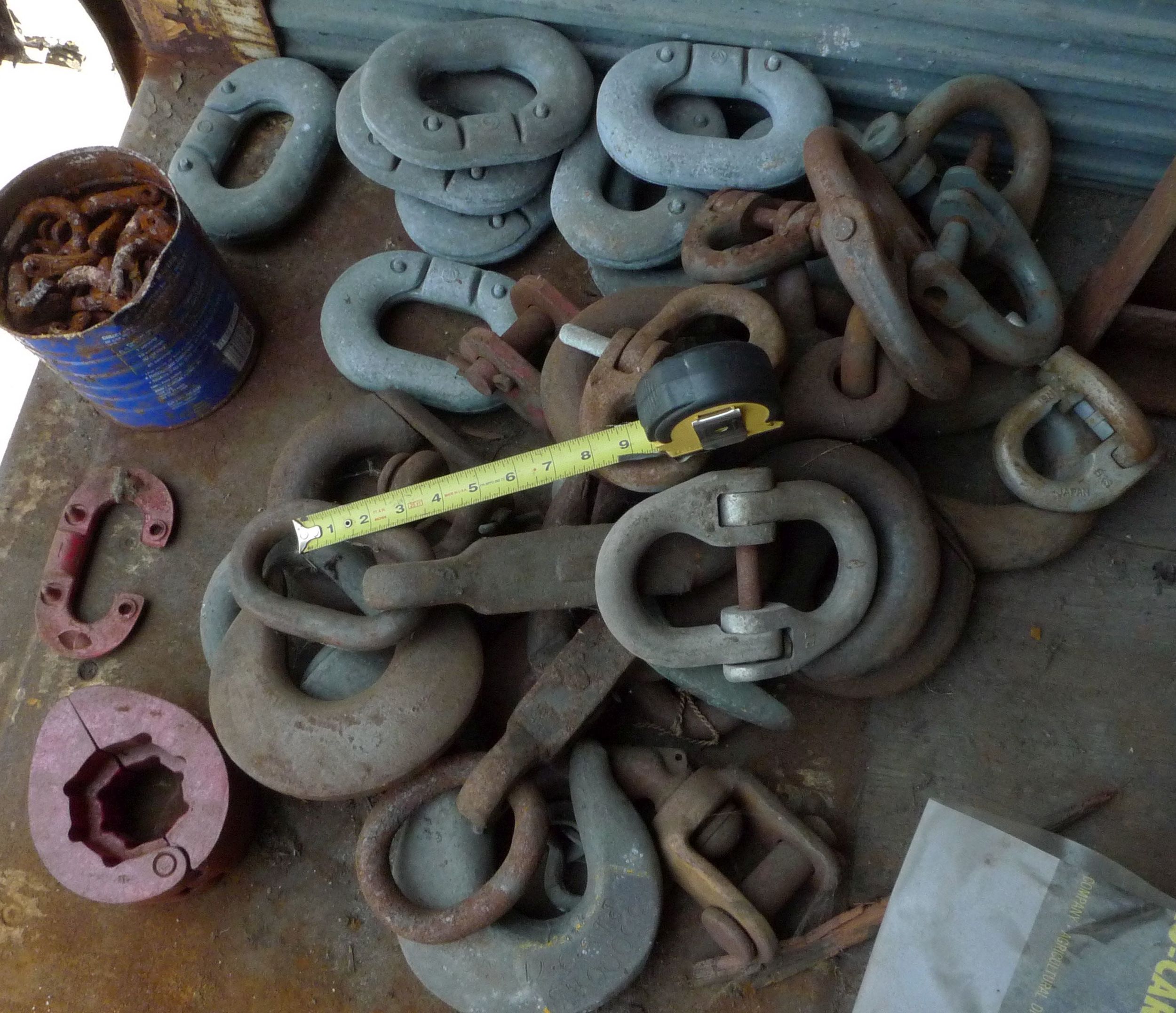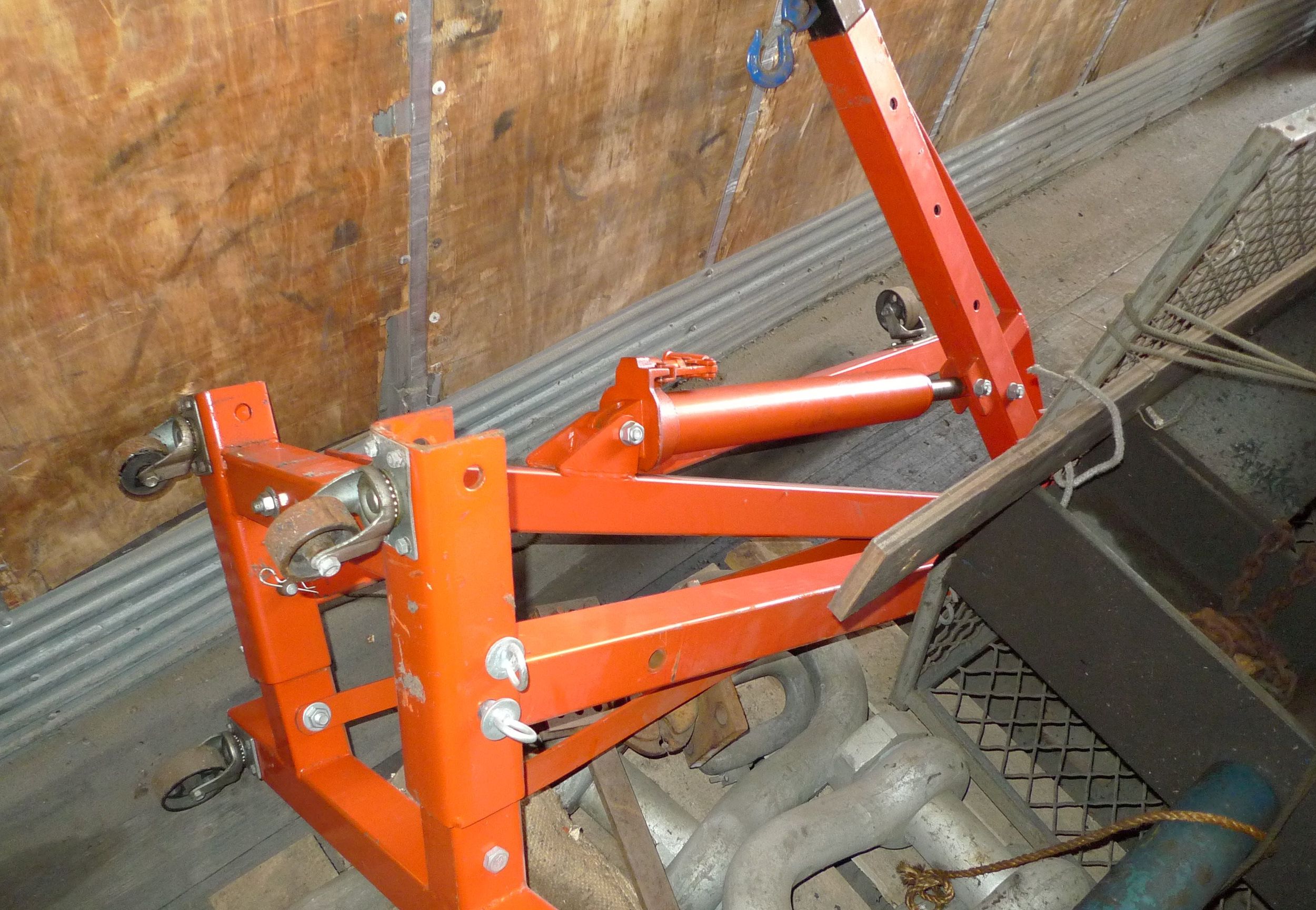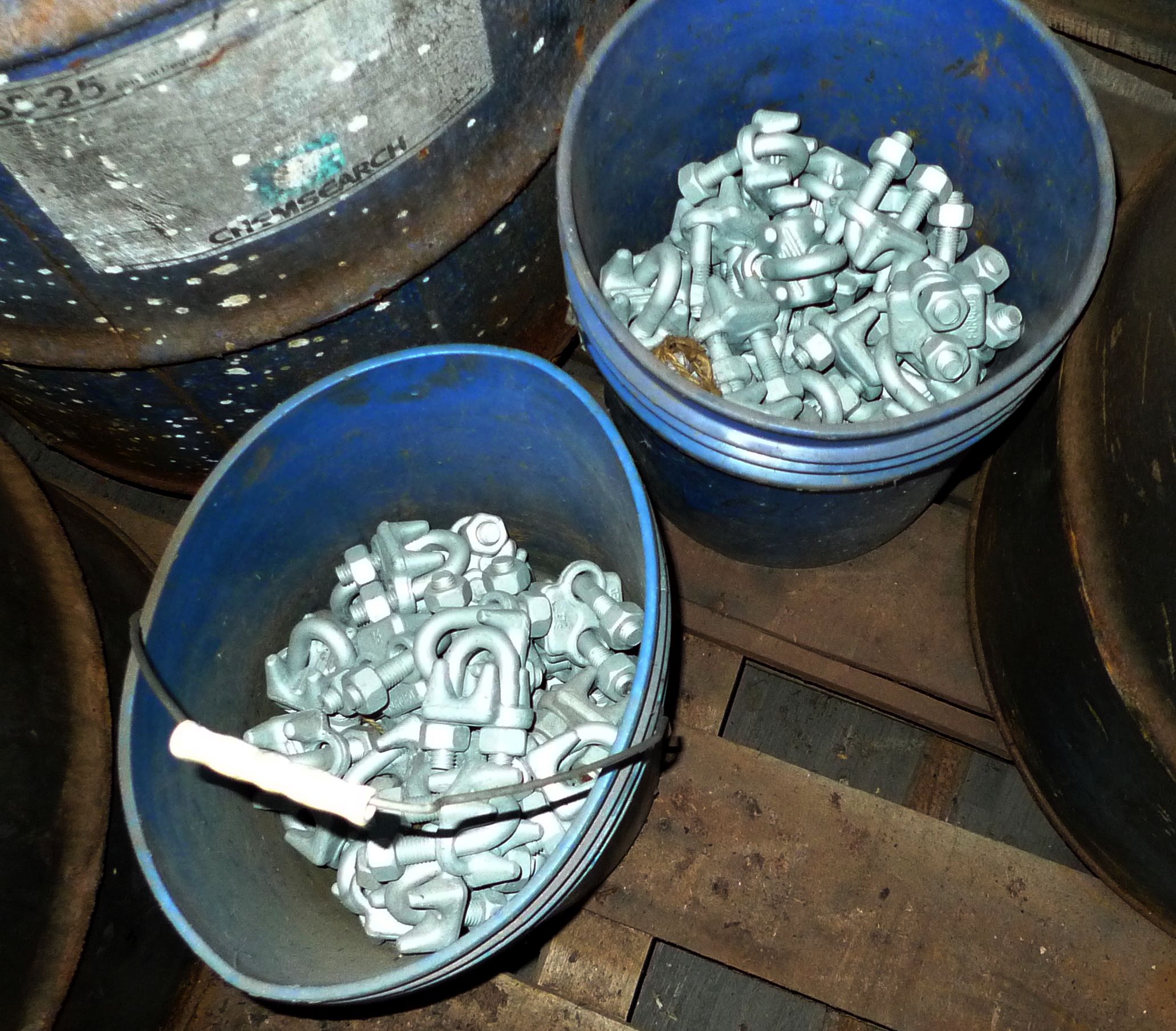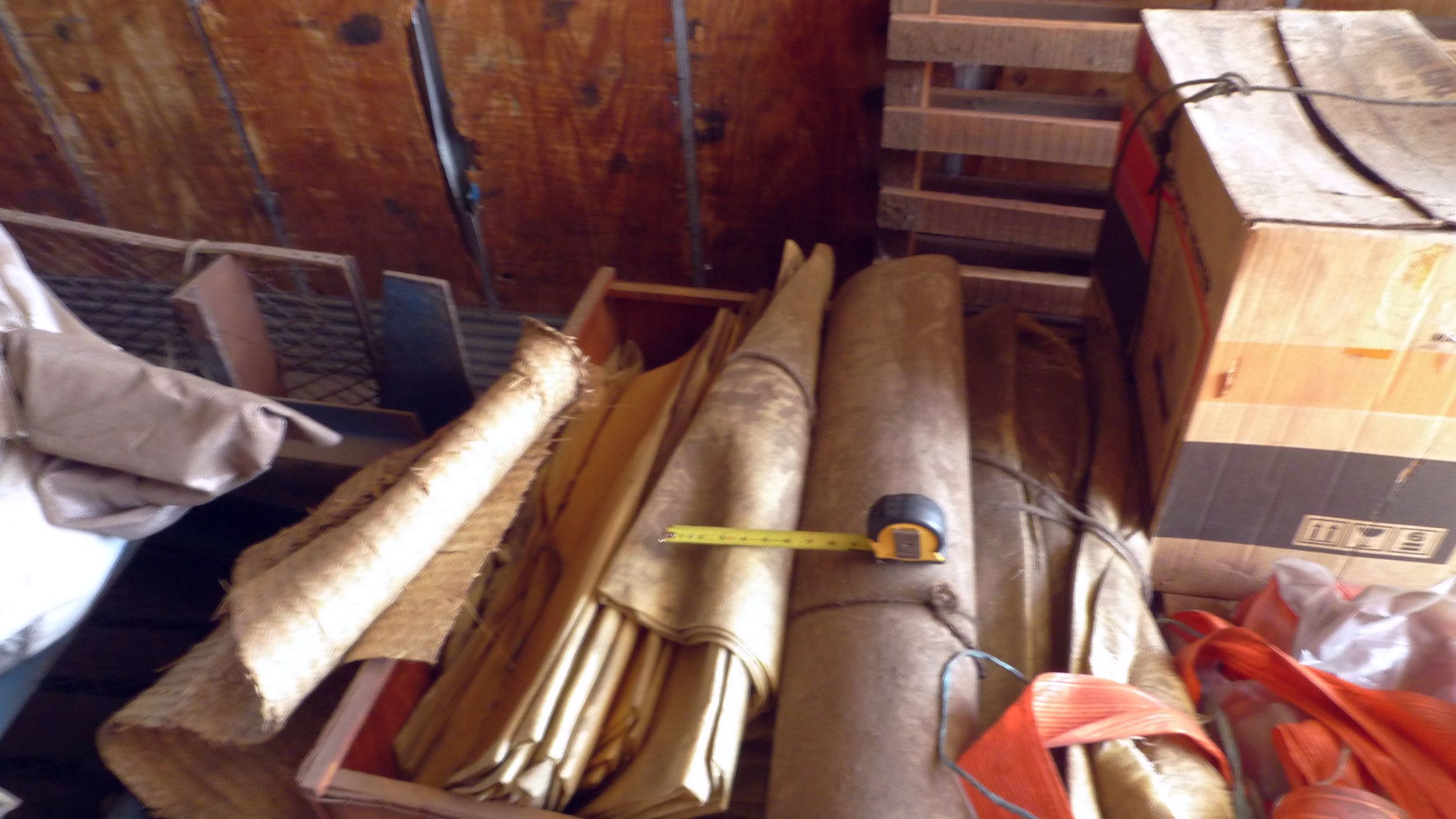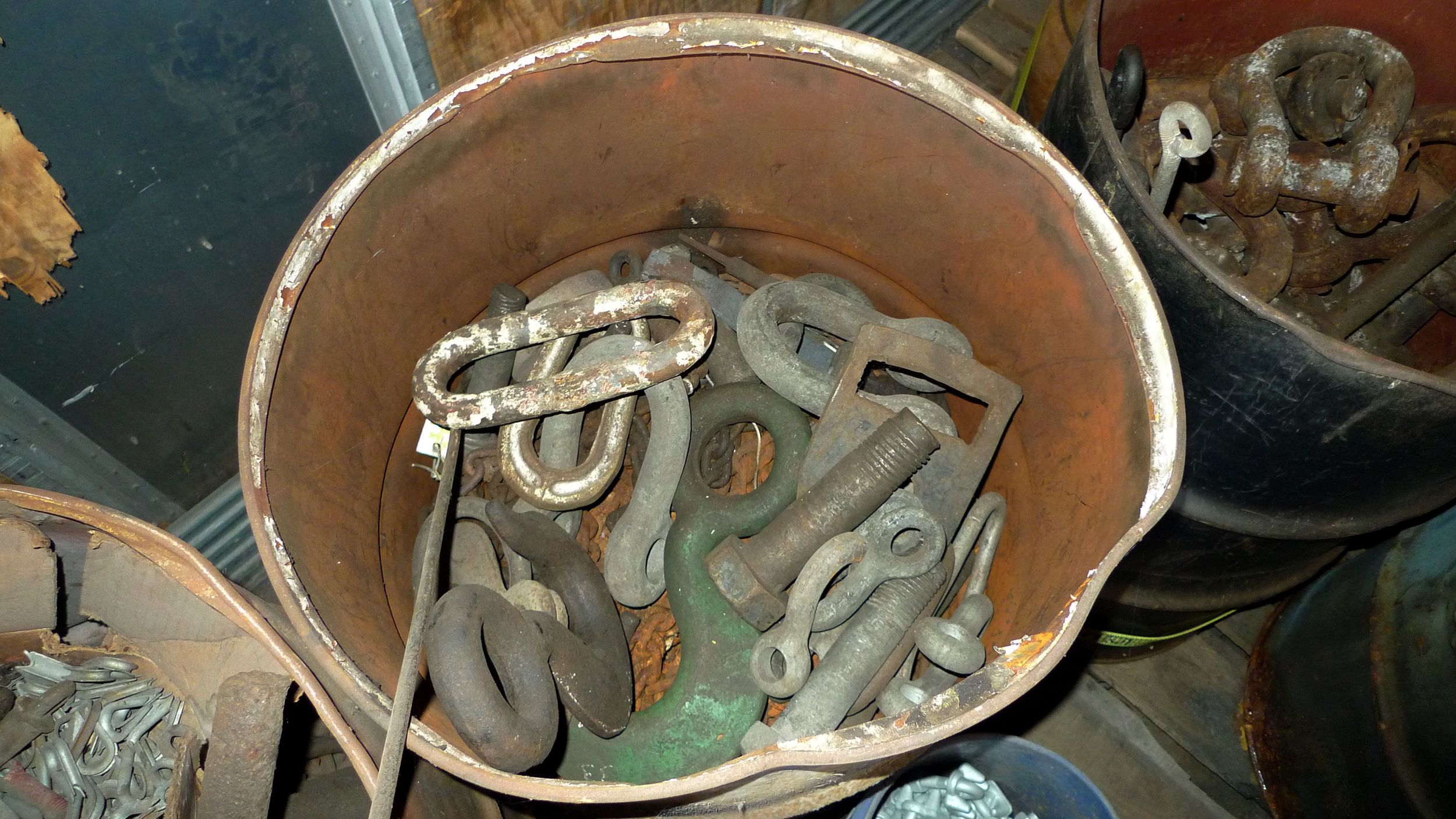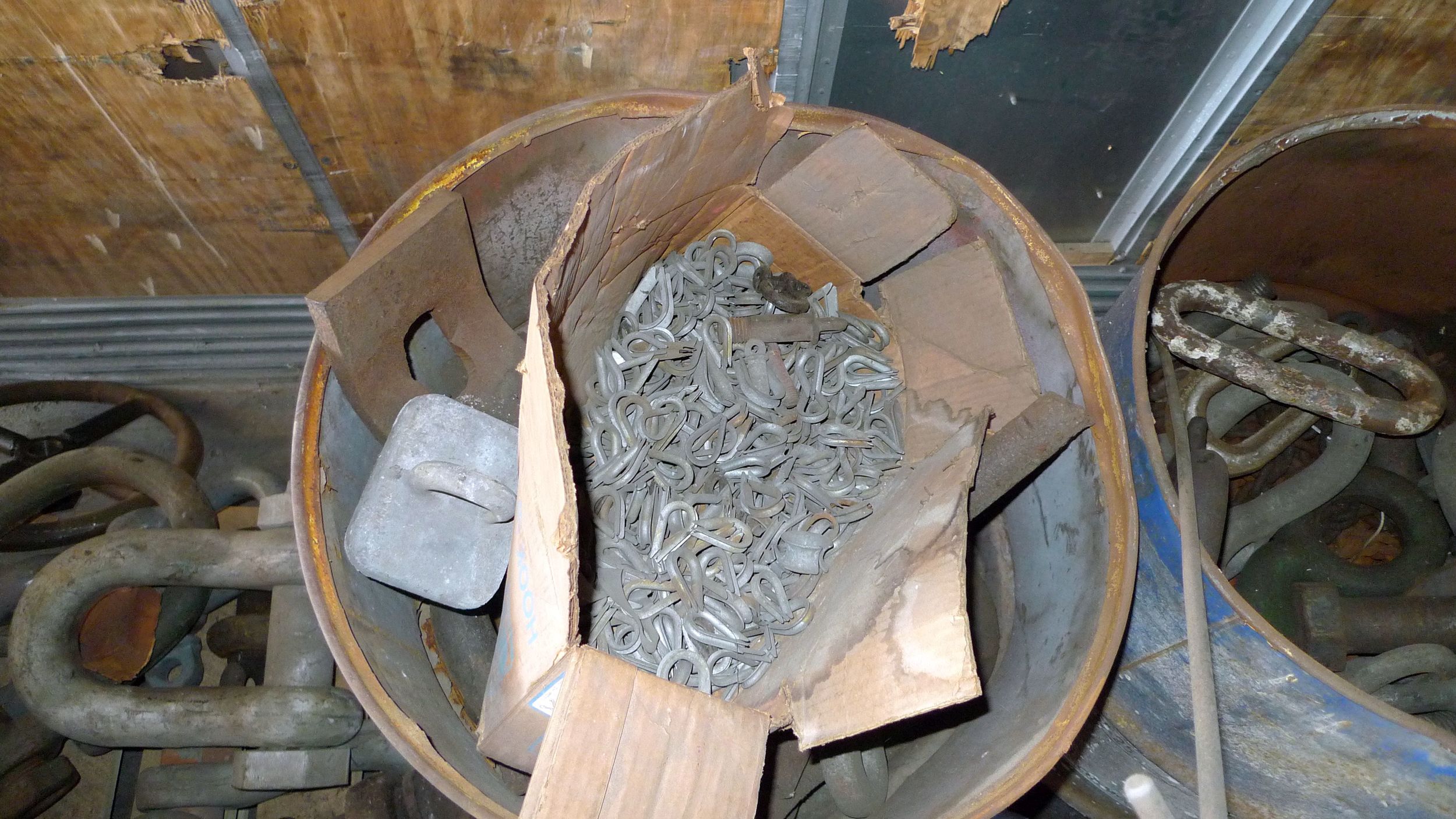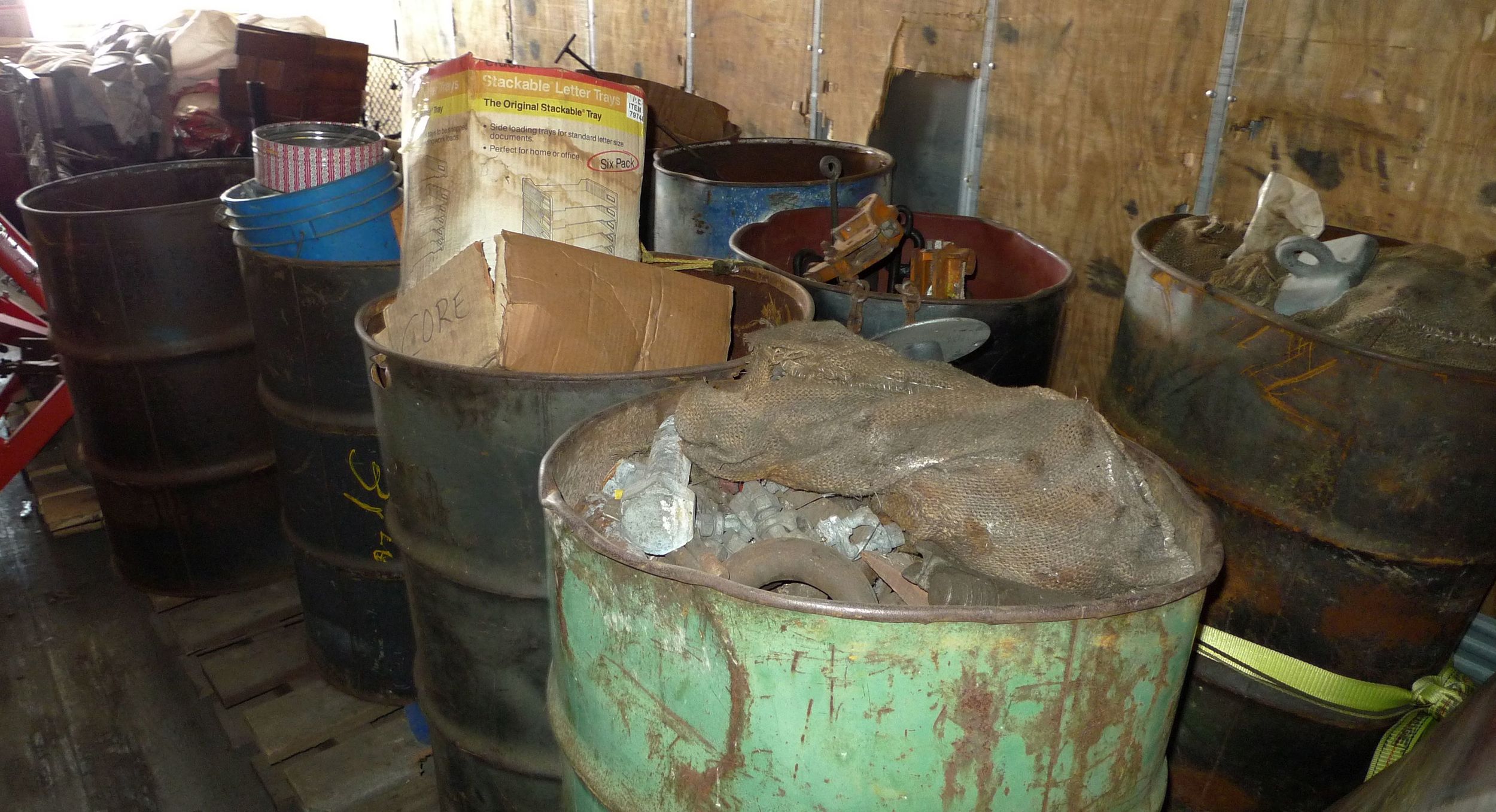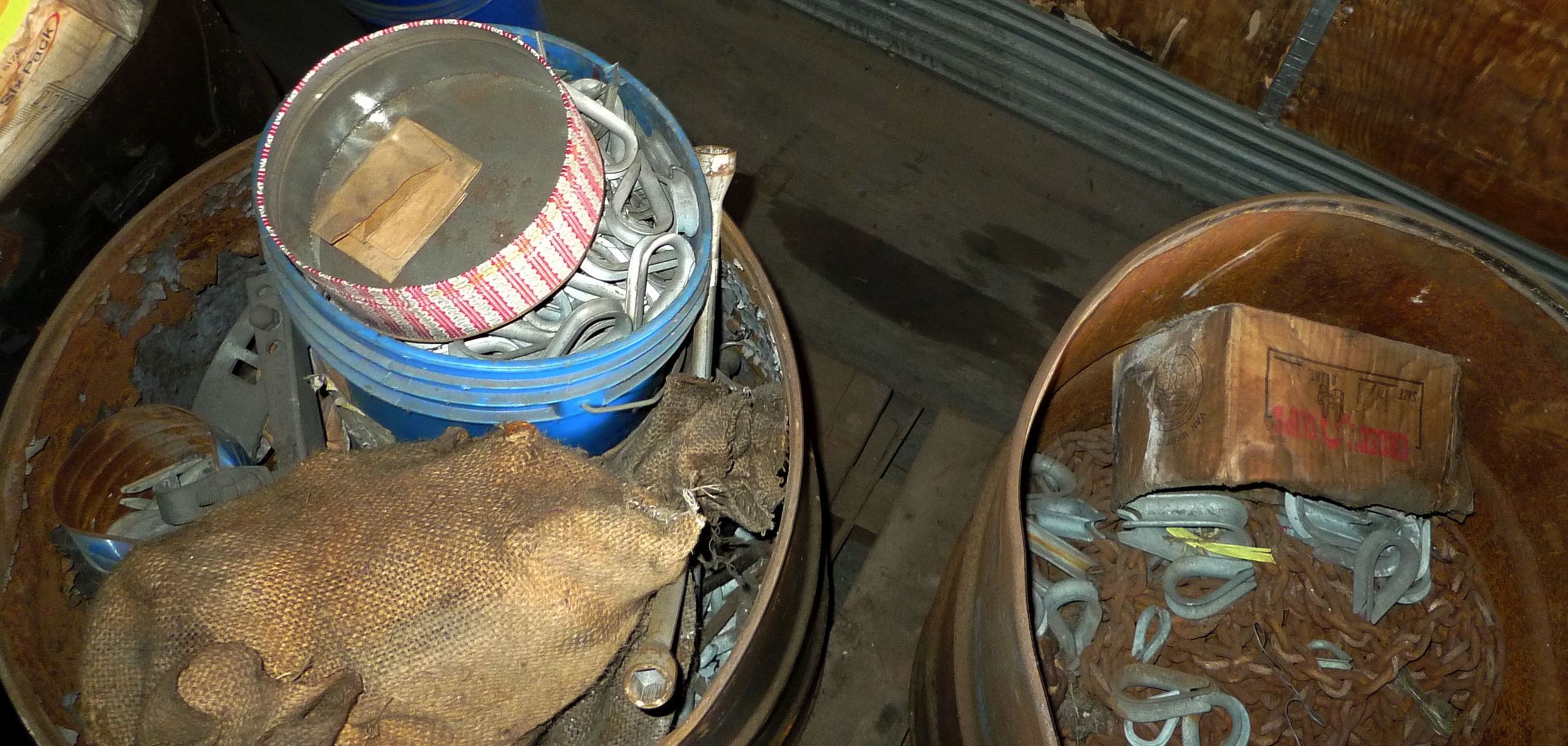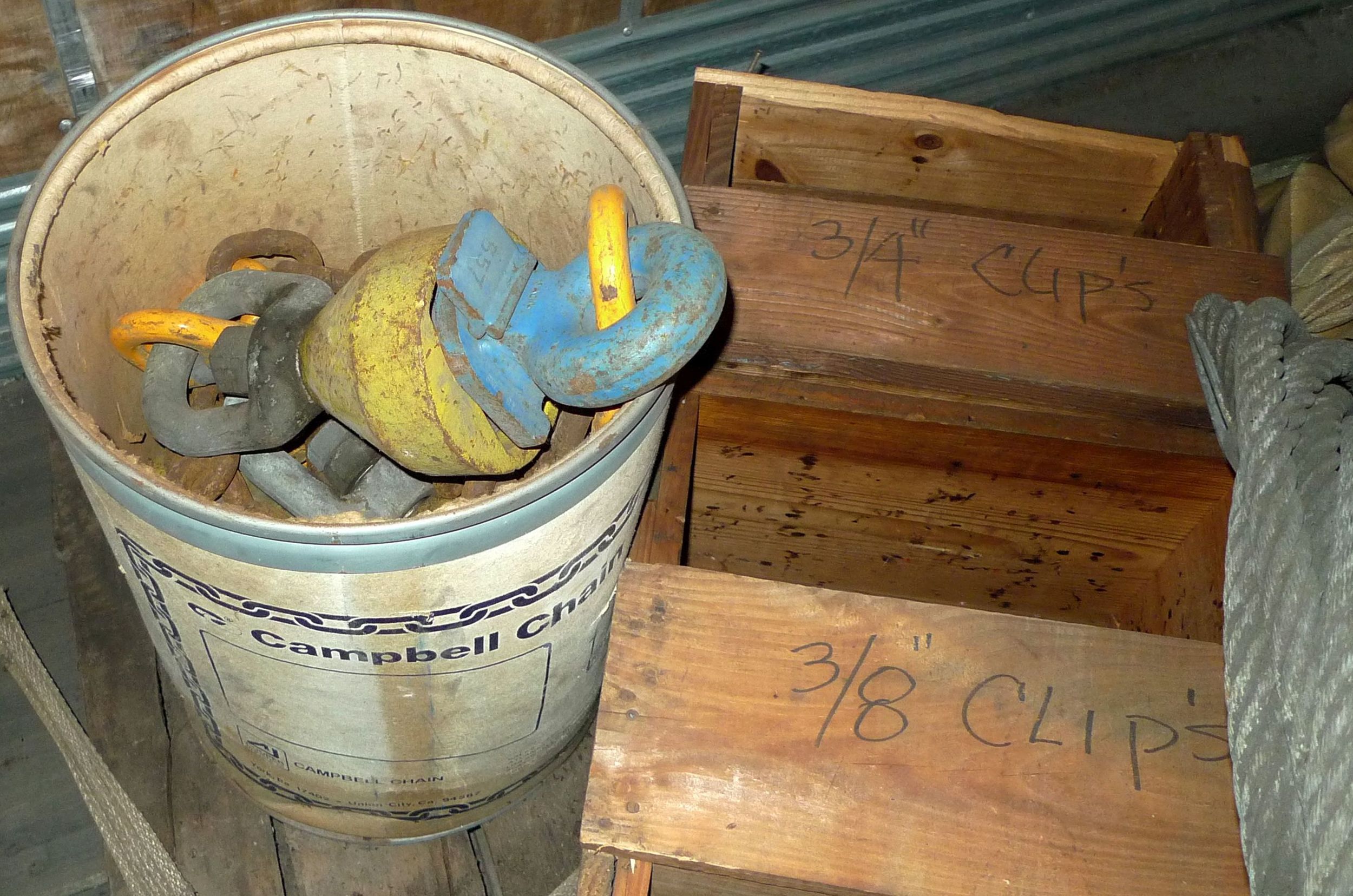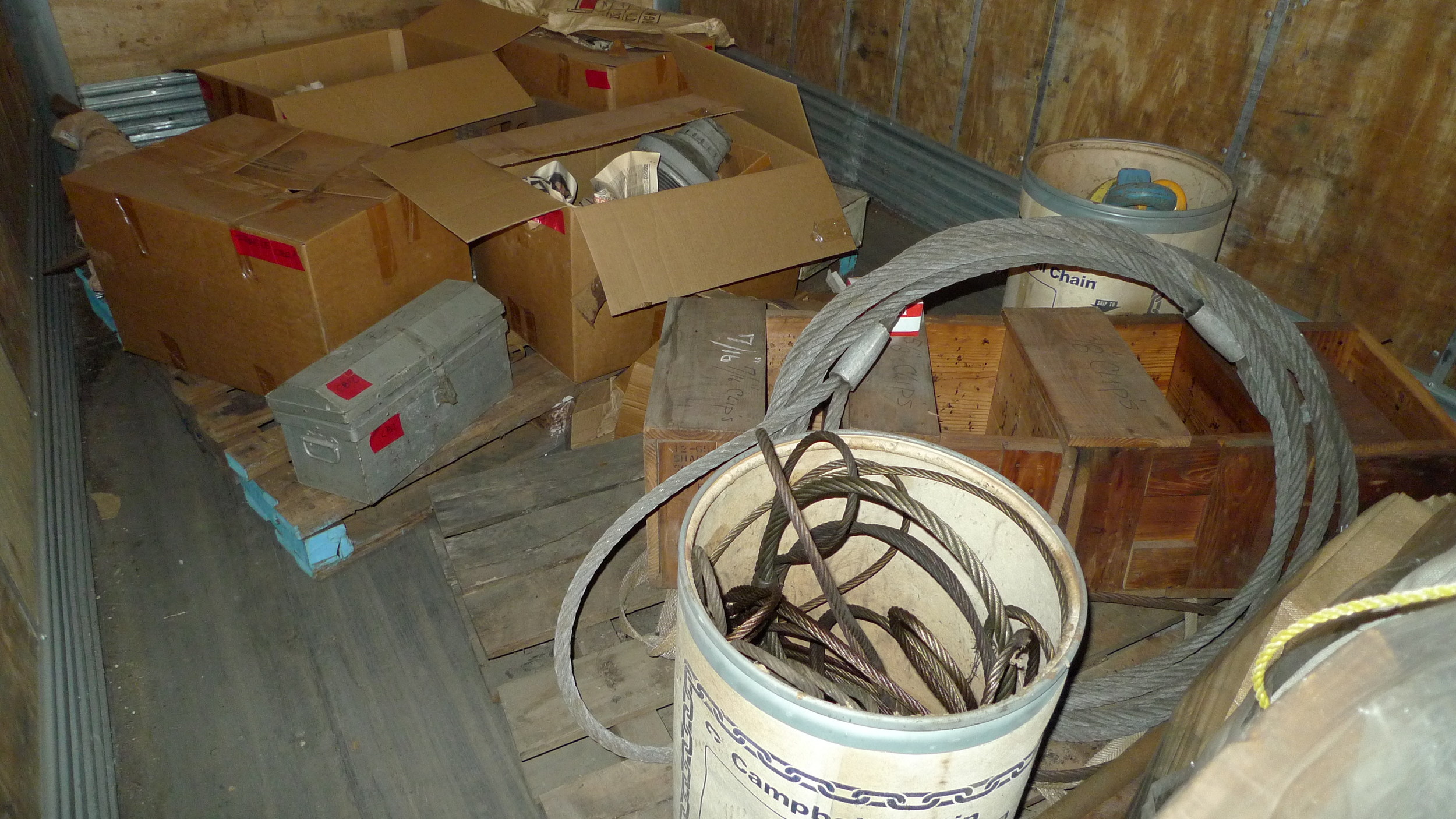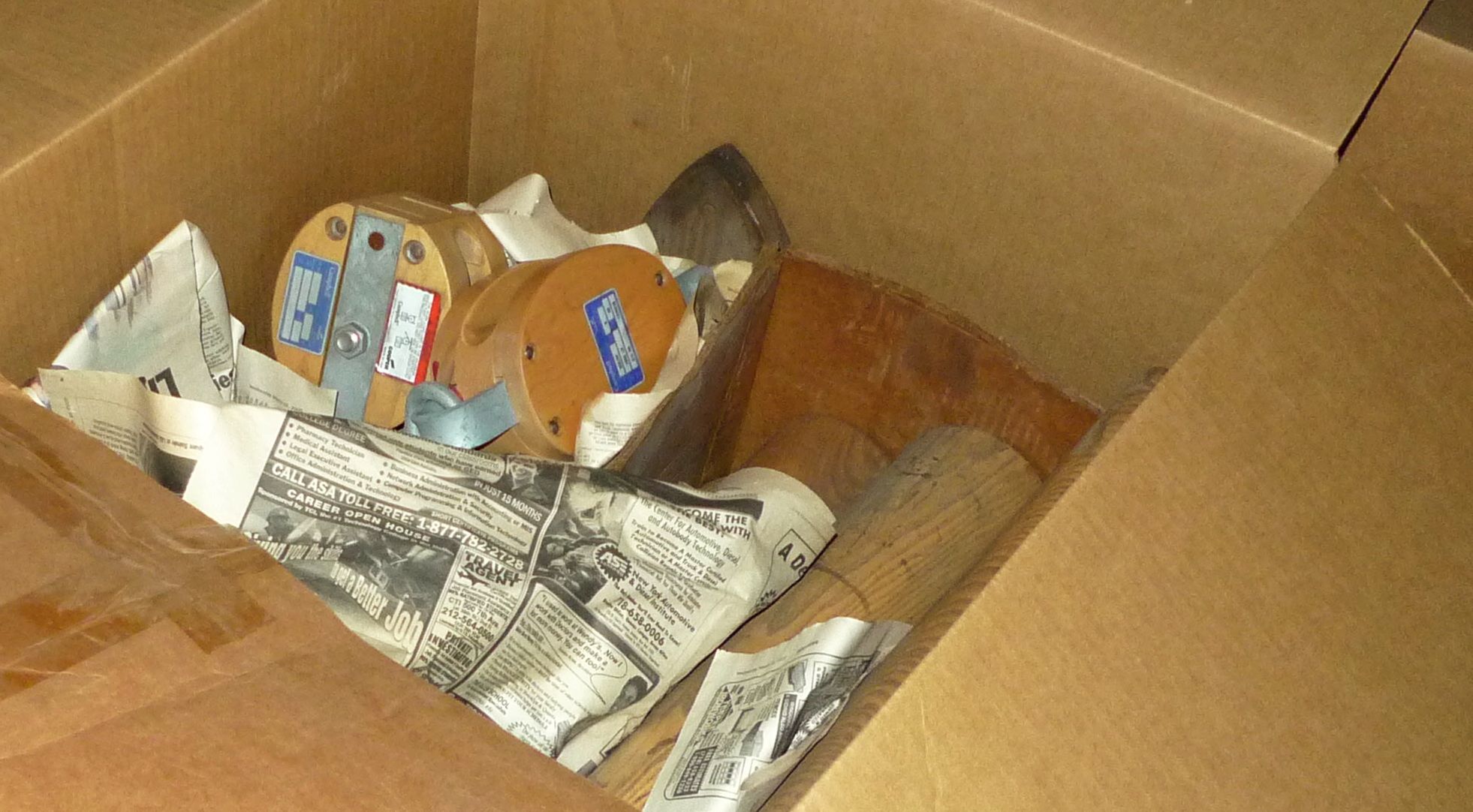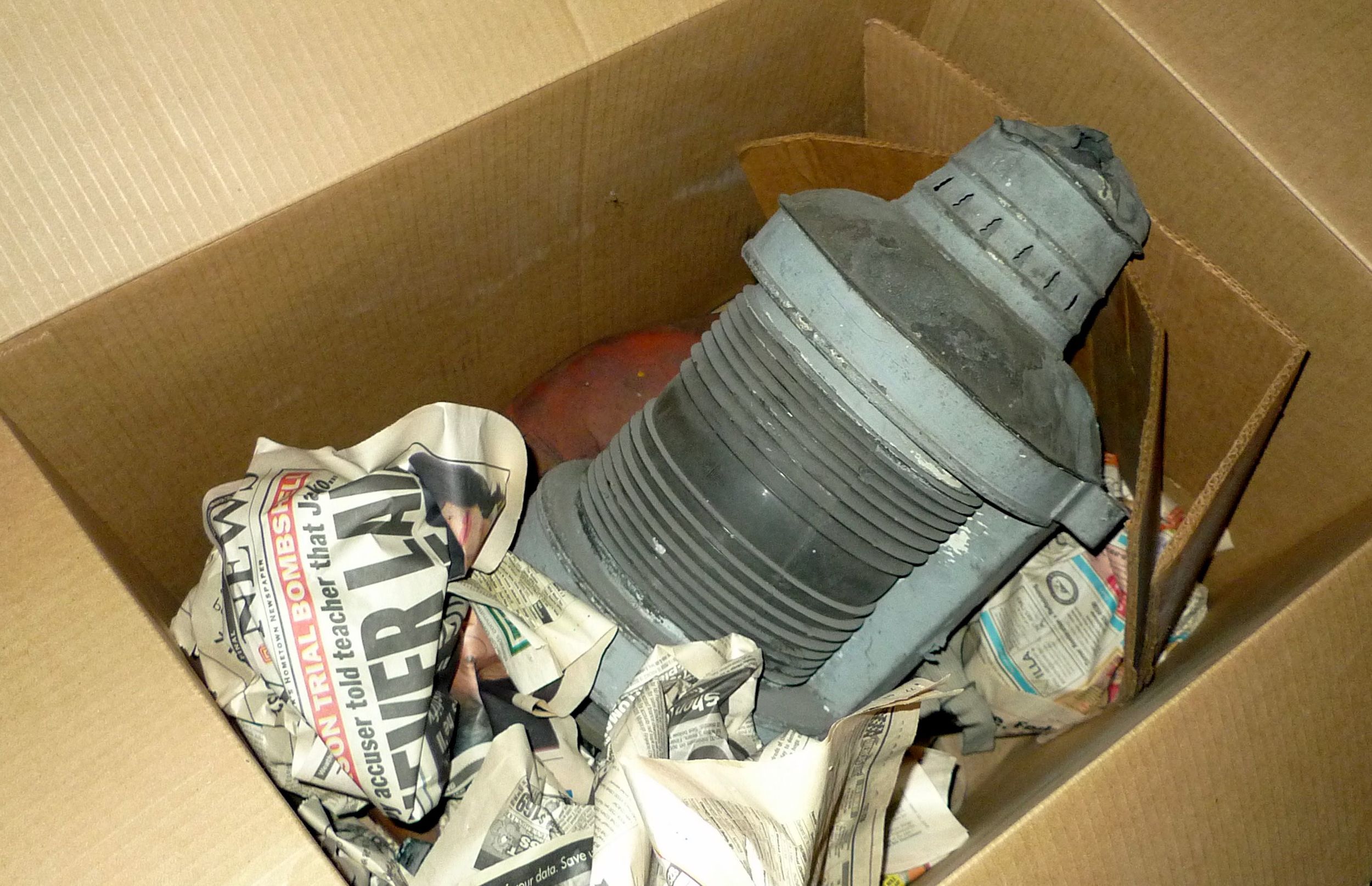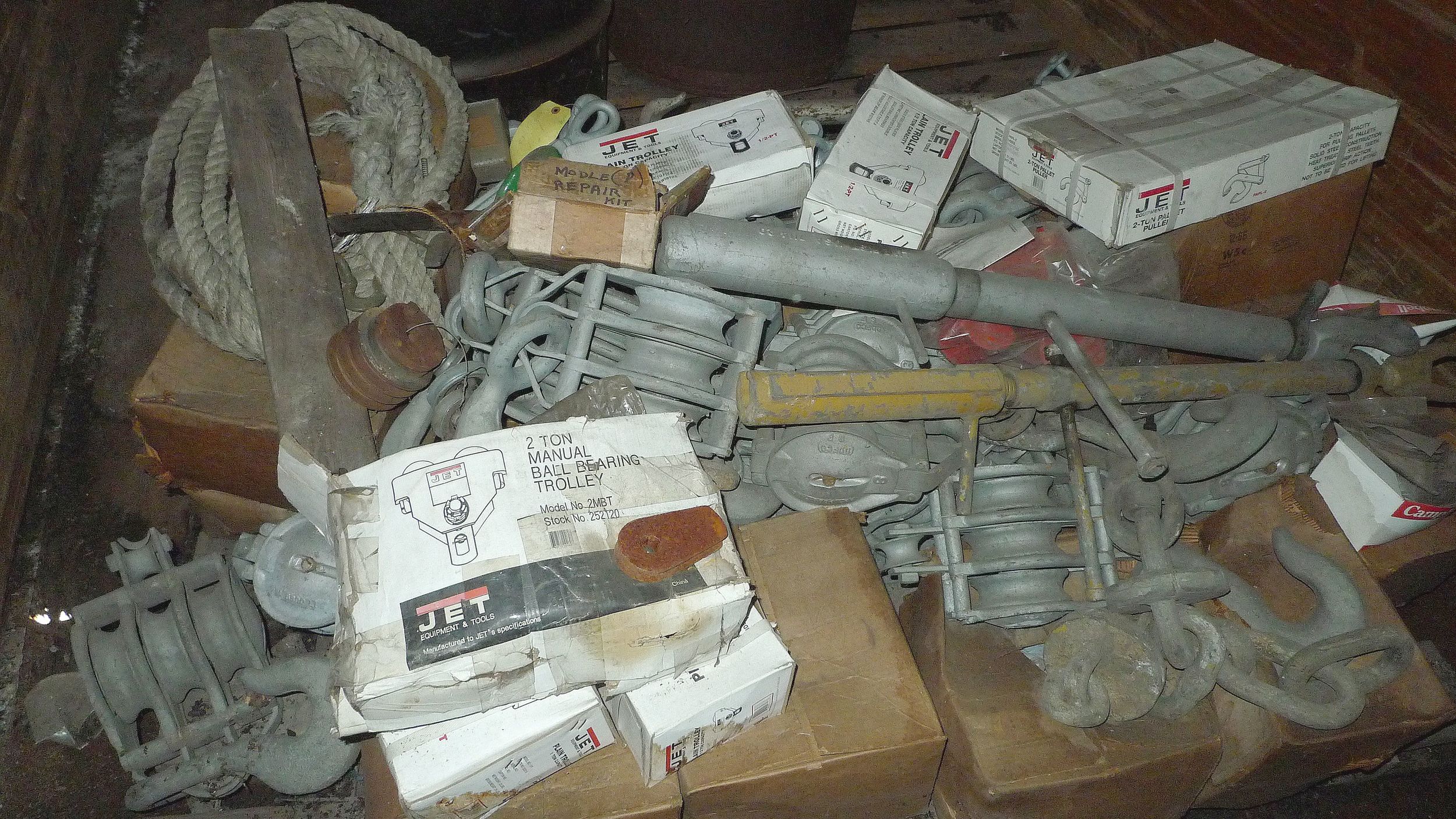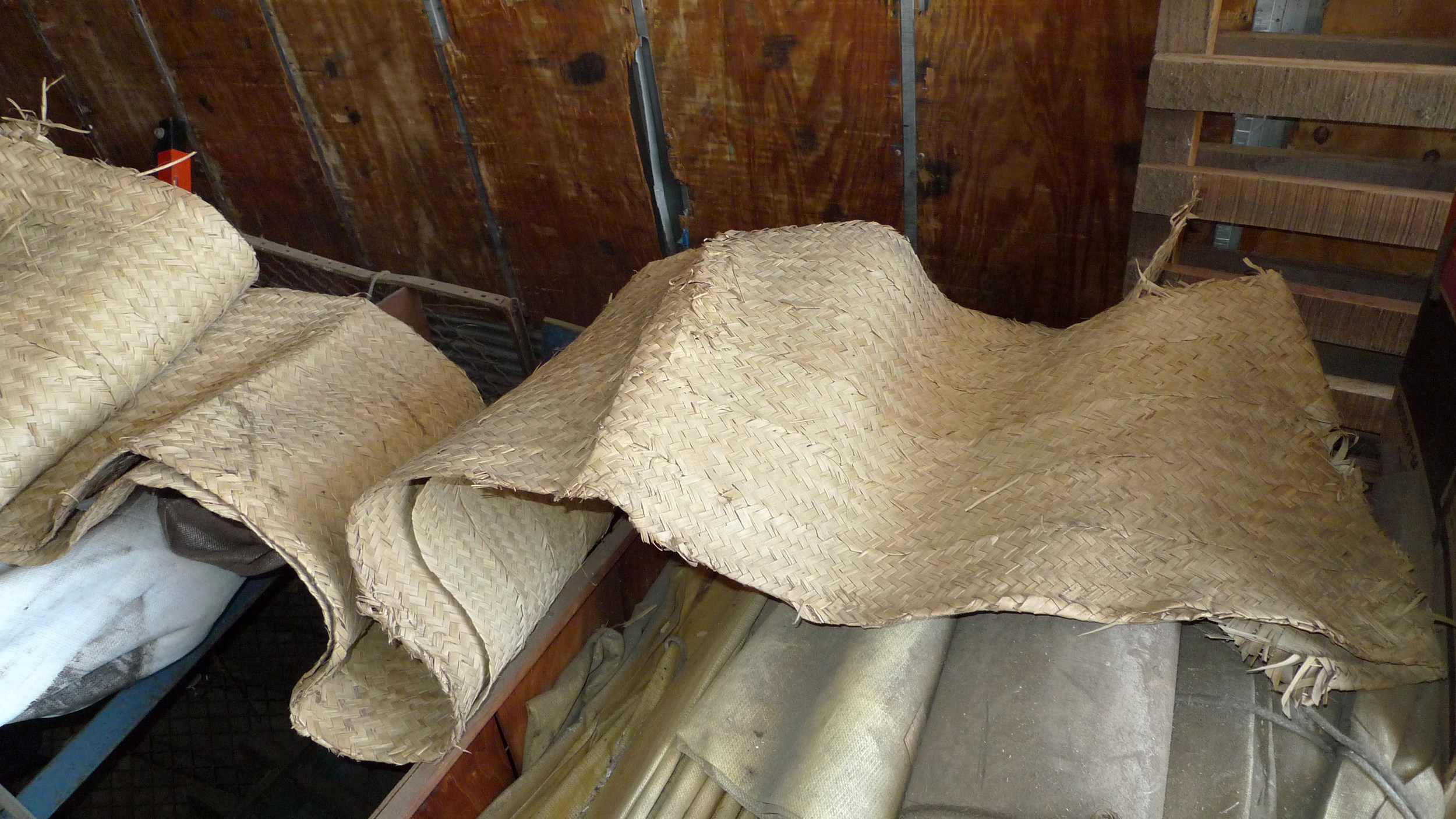2023 PortSide year-end report
/Recap of PortSide’s 2023 impact on public policy, education, and historic preservation! And the year’s not over! There are December milestones and news in here!
Read MoreNYC needs more #piers4boats! PortSide’s blog covers our WaterStories programs, urban waterways issues, the BLUEspace, development plans for the NYC waterfront, our ship MARY A. WHALEN, other historic vessels, and boats and ships of all sizes.
Recap of PortSide’s 2023 impact on public policy, education, and historic preservation! And the year’s not over! There are December milestones and news in here!
Read MoreA water-themed history trail about and for fascinating Red Hook, Brooklyn. It will educate visitors and locals, help revitalize Red Hook and help protect this community from floods. It tells NYC's maritime story in microcosm. This year, we are launching a pilot multimedia map and creating a hard copy visitor guide and signs with QR codes around the neighborhood that alert people to the website. We will create large, outdoor, exhibit panels with this content. We are taping more oral histories to share.
PortSide offices aboard the ship MARY A. WHALEN are a buzz as we push ahead with Red Hook WaterStories. Many new consultants and interns have come aboard to help develop and catalog content. The accessibility of our new home is allowing people with valuable skills, but no prior relationship to PortSide, to literally step (or ride their bicycle like David Levine) up to the pier and get involved.
We thank Councilman Carlos Menchaca both for seeing the importance of our new home and for the $20,000 in funding that is pushing the project forward. We have applied for other funding, and have launched a campaign to raise another $20,000 by then end of June 2016.
Our Curator and Historian Peter Rothenberg has been joined by a team of consultants, advisors and interns. Some are interviewing, some research archives, some are deep in the html end of the archive. Bios of the team on the Red Hook WaterStories webpage.
We have been collecting new content and looking backward, meaning we sought technology and advice on how to get our archive coded and organized. David Levine has 25 years experience in content management at major corporations and is leading the tech end of the project, selecting the software for content management and website creation. Lots of conversations between him, Peter and new advisors Johnathan Thayer and Marilyn Oliva helped selected us Omeka as the archivist software to use. The first version of the multimedia RHWS website may be Omeka itself. Much to learn and code in all this!
Johnathan Thayer teaches archival practice and preservation at Queens College and is the Senior Archivist at Seaman’s Church Institute, founded in 1834 which has thousands of items and oral histories in its collection. Despite all that content, they have nothing about Red Hook in their files – proof that PortSide’s project has something to contribute.
Regina Carra, a graduate student at CUNY Queens College studying Library Science and History, learned about RHWS from Johnathan and was so excited by the project that she rejiggered her schedule to work with us one day a week.
We have had long meetings and brainstorming sessions around the galley table to discuss what themes, issues and peoples to include so we know to look for such content and have the archive coded in advance to be ready to receive that kind of content. “War” and “”military,” how are they the same or different? With our focus on immigrants who arrived by water or worked on the waterfront, what do we do about the “non-ethnics,” the English or WASPS? How do we deal with false history (the errors so often repeated in the era of Google)?
Do we include a layer that explains sources so people can see that many a map or engraving that has been used to show “this was Red Hook” is an illustration of a plan, an intention, and did not yet exist? That kind of discussion is so pertinent to the resiliency (flood prep) aspect to Red Hook WaterStories.
As a water-aware organization, we planned to talk about underground water issues since we started this work in 2005. After superstorm Sandy, information about the historic filling of creeks, swamp and shoreline is very timely. It's key to understand that so many historic maps of Red Hook show a street grid of intentions over “land” that remained water and swamp into the 1900s. On a lighter note, in honor of our ship cat Chiclet and her devoted followers, we decided to add cat WaterStories. History needs to be fun too!
We have a bottomless font of facts and tips about the history in advisor Norman Brouwer, a noted maritime historian and the person who built the South Street Seaport library. He also has a personal collection of thousands of maritime postcards which we hope to access for illustrations.
Julia Golia, Director of Public History at the Brooklyn Historical Society, told us about resources in their archives and was receptive to partnering as they move ahead with their waterfront museum and waterfront history website in partnership with Brooklyn Bridge Park.
Melinda Boros, an immigrant from Romania, brings us a fresh perspective in her role as consultant. Red Hook was one of the first neighborhoods she found after emigrating in 1998. It's abandonment was something she expected in Ceaucescu’s Romania not the USA, so she dove deep into historical research to come to understand it. Barbara Wye, a recent grad in Anthropology and Digital Media Design with experience in community organizing around preservation, is helping with outreach, event planning and graphic design.
Many Red Hook WaterStories involve Spanish speakers, especially since the first point of arrival for Puerto Ricans in NYC was ships docking at Red Hook piers. Intern Ivy Ann Rosado, a senior at Hunter College of Dominican heritage is helping with this research and other aspects of the project.
We are interviewing more people for more video and oral histories. Jenny Kane leads the oral history work. John Weaver handles the video camera. Our President Carolina Salguero, an award-winning photojournalist in her prior career, does some of the interviewing.
If you, or someone you know has some Red Hook WaterStories to share, get in touch! WaterStories include: all things working waterfront (shipbuilding/repair, ports/freight movement, creation of ports/changing shoreline, merchant marine/worked on boats, ferries), emigrated here by ship, worked at waterfront facilities, played/fished/relaxed on the waterfront, waterfront religious rituals, drownings, Sandy experiences, created an art work or piece of literature inspired by the Red Hook waterfront.
This project is supported in part by the New York State Council on the Arts with the support of Governor Andrew M. Cuomo and the New York State Legislature, and funding from NYC Councilman Carlos Menchaca.
2015 was a year of major milestones and growth. See, read and feel it below.
The pivot point was the exhilarating move on May 29 in the video at right.
Our new site strengthens our ability to fulfill the PortSide vision of combining the working waterfront, public access and community development.
Please donate now and support our momentum!
The public access at our new home enables us to grow our educational programs. We hopped on it right away with outreach such as our Open House for Educators Week and researching new curricula. We gained new partners in the World Monuments Fund, the Williamsburgh HS of Architecture and Design (WHSAD), and Behind the Book. We had three summer interns from WHSAD and two college interns from Spain. We created a curriculum for simple machines aboard the MARY A. WHALEN and taught Hurricane Sandy & resiliency to elementary school kids. For adult job training, we furthered our relationship with the painters' union District Council 9.
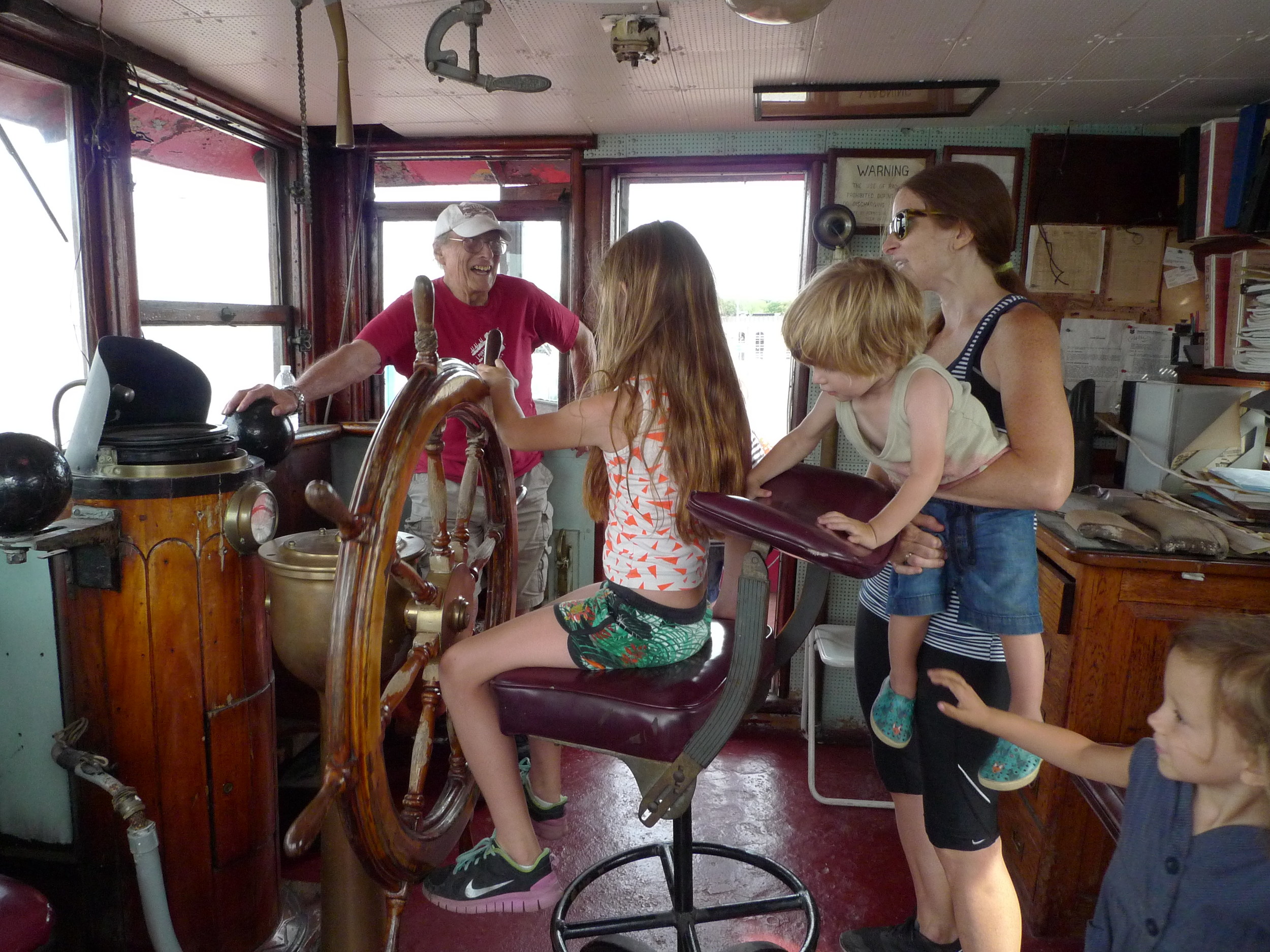
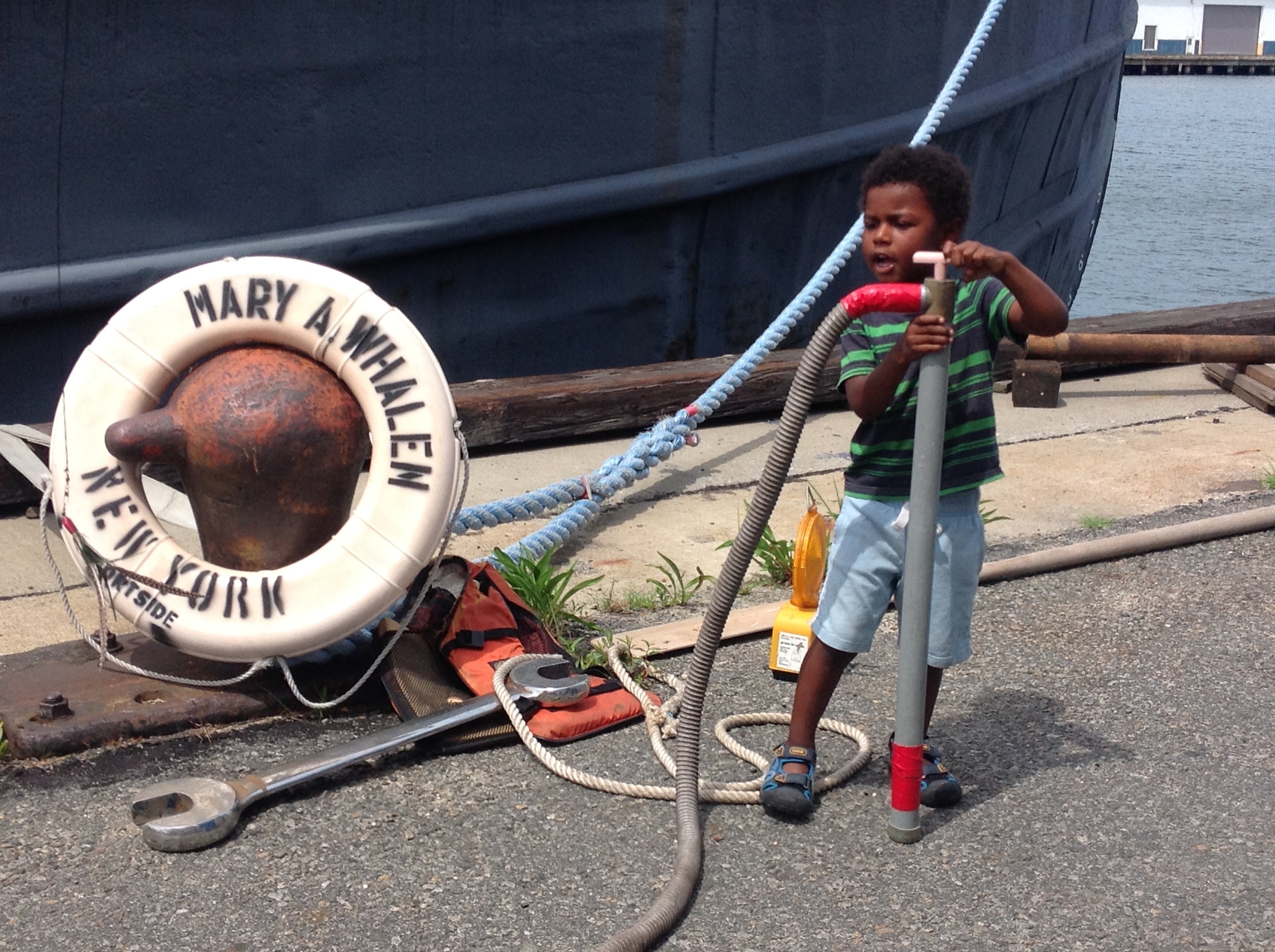
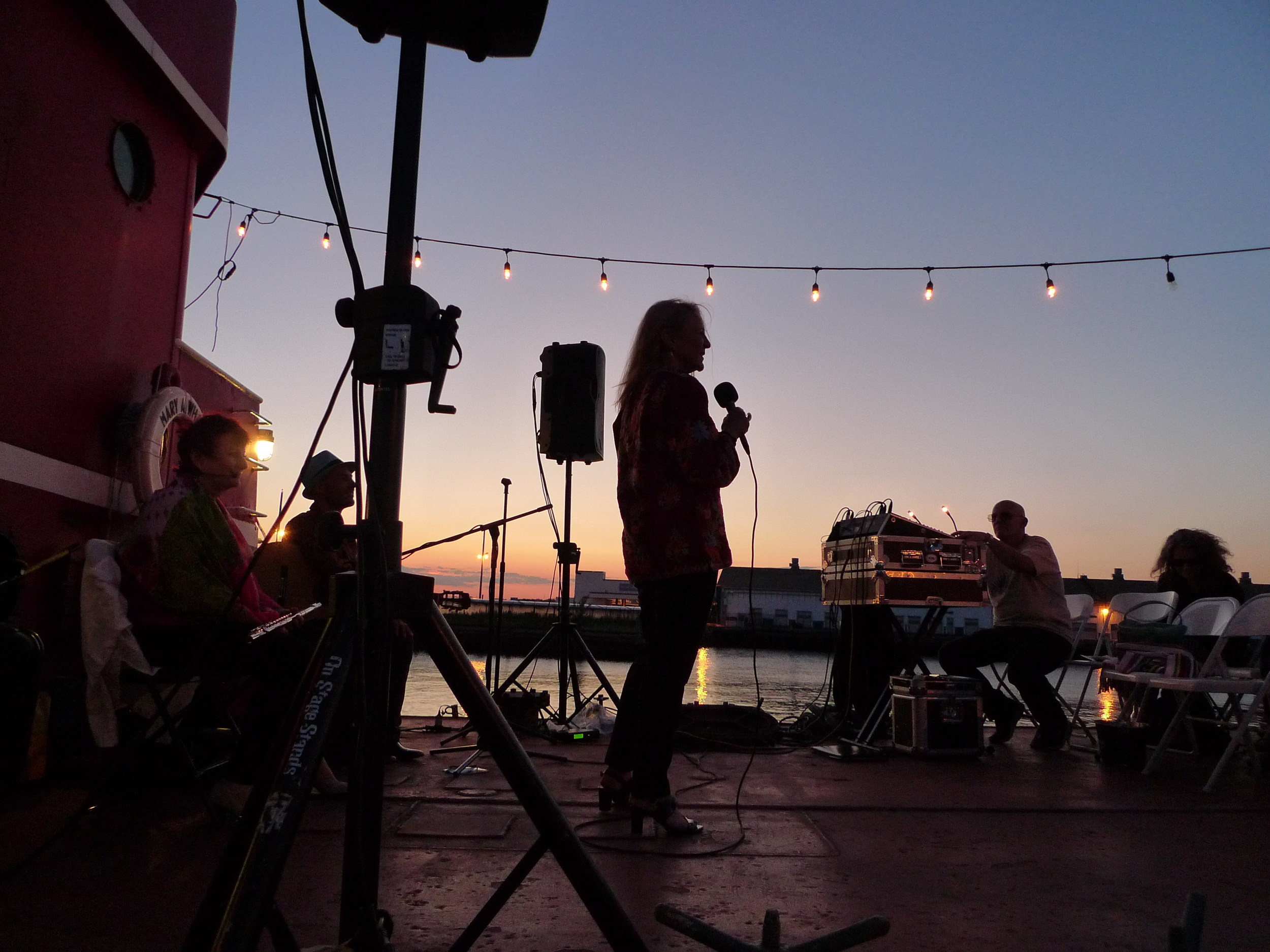
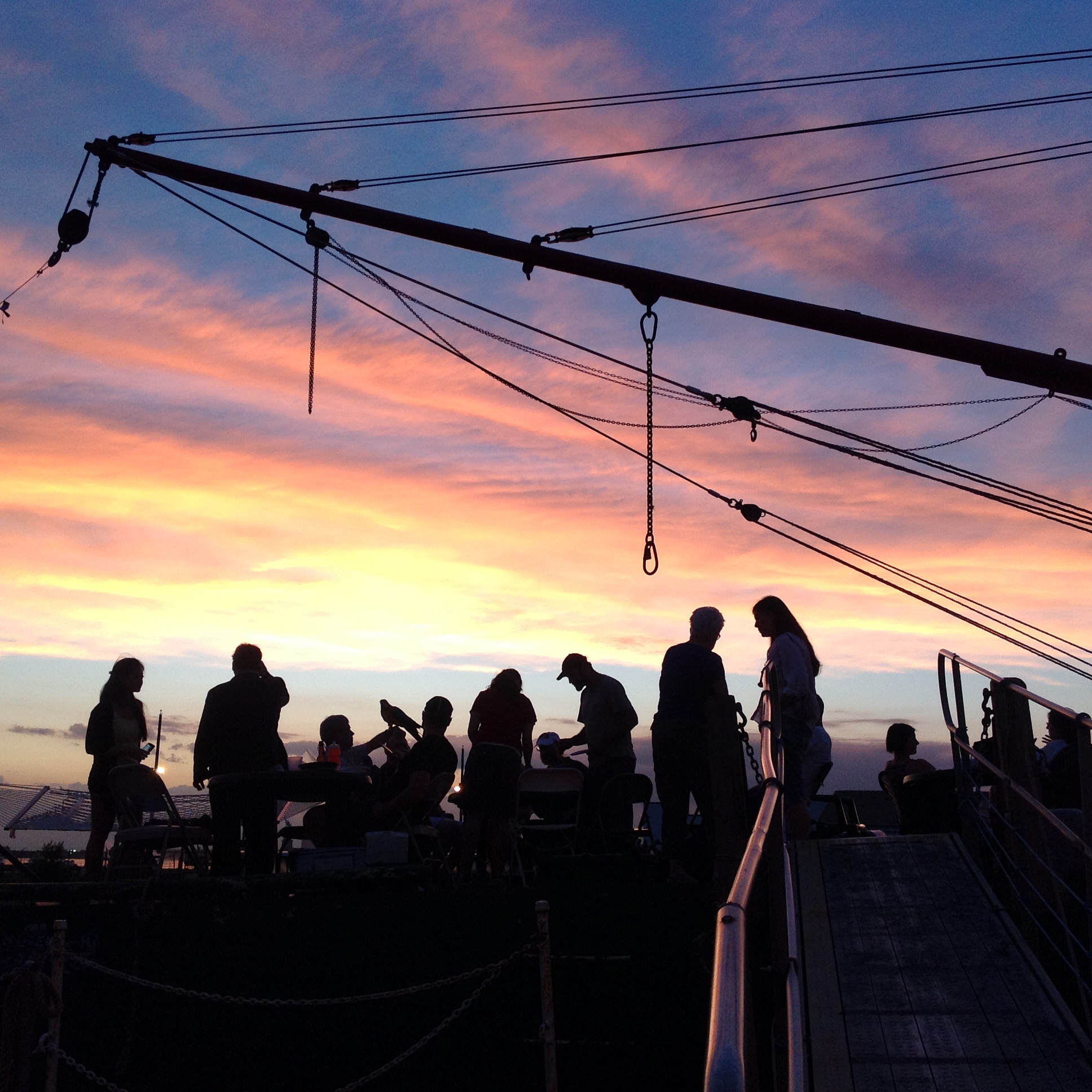
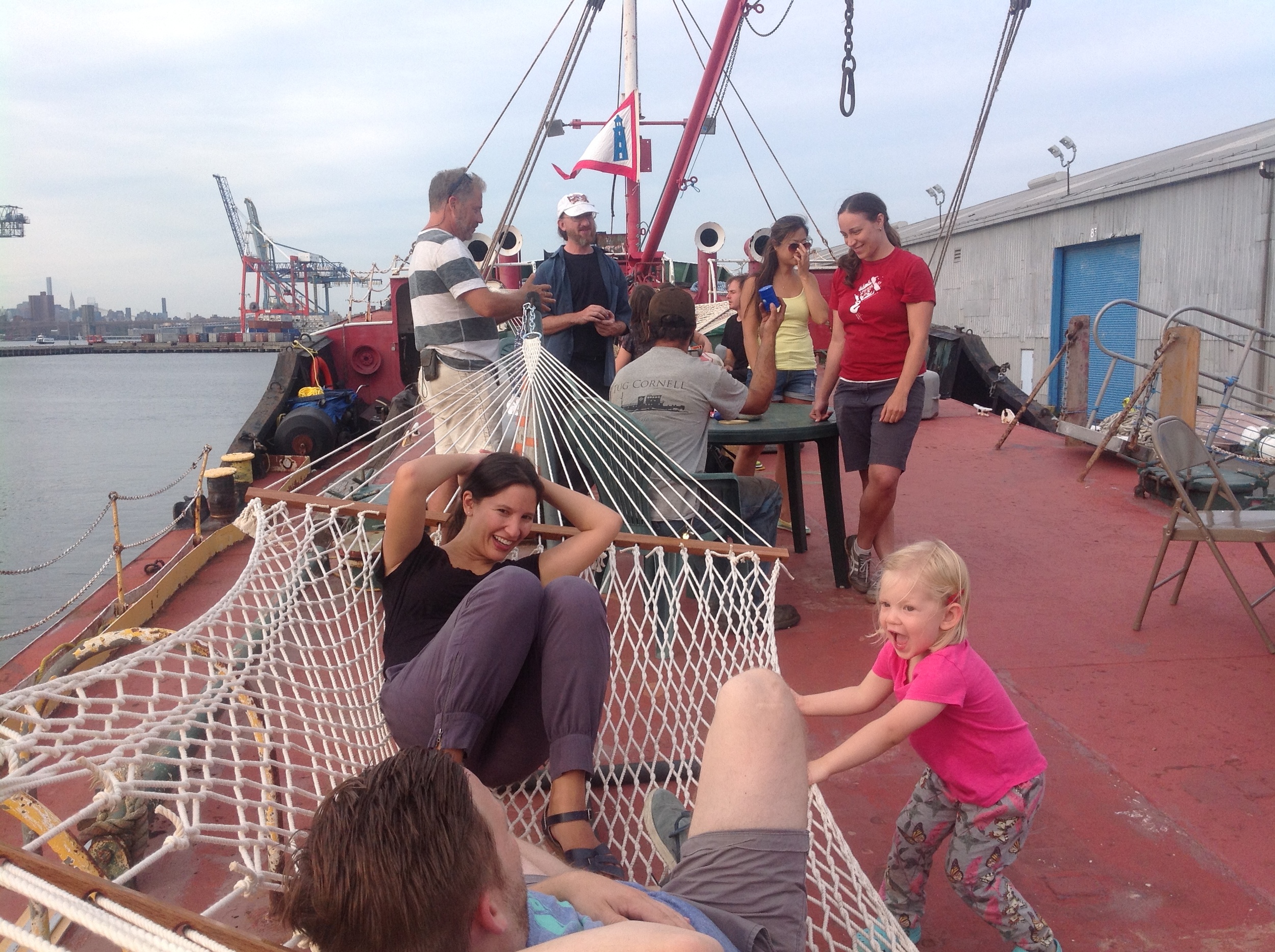
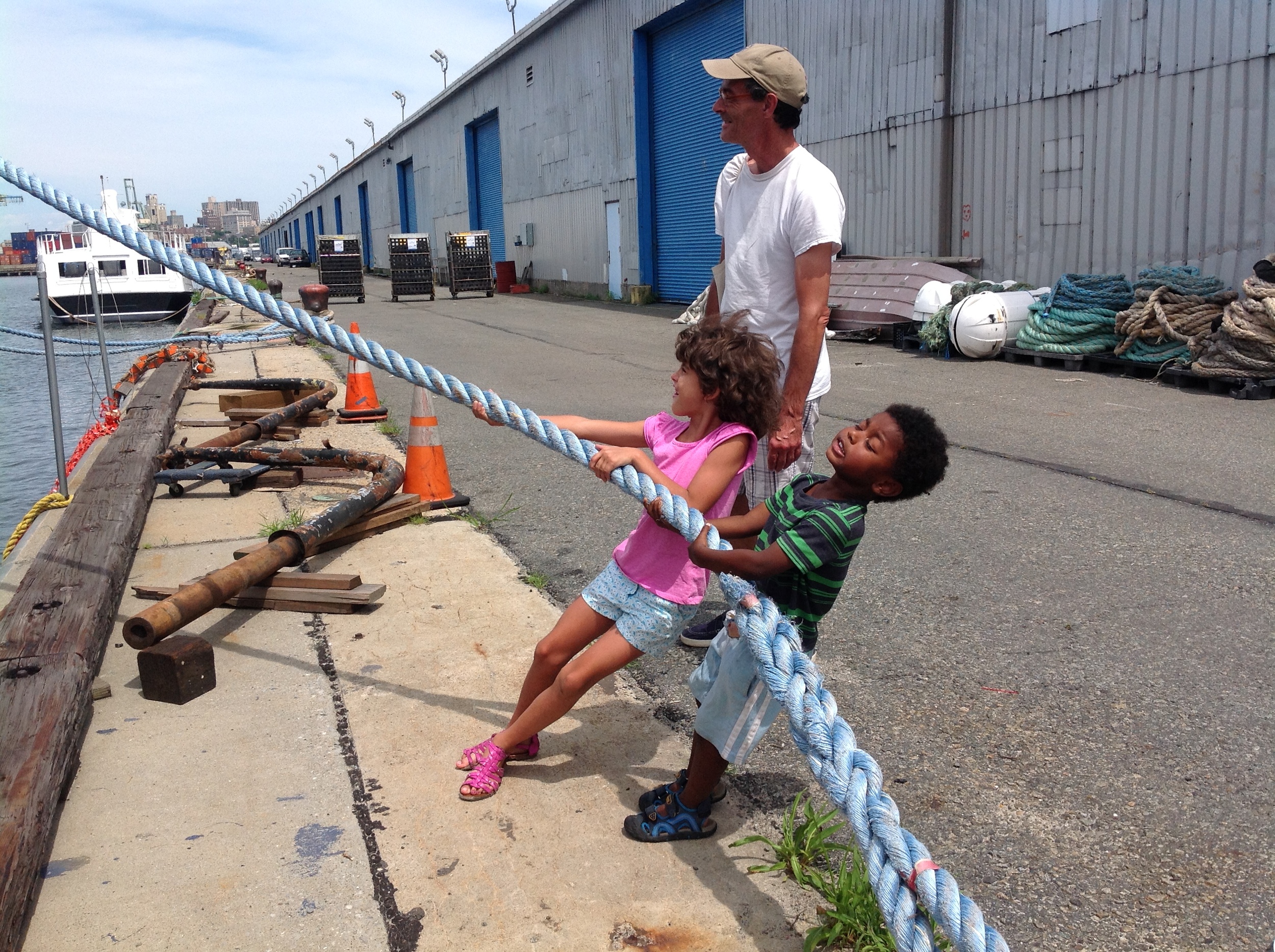
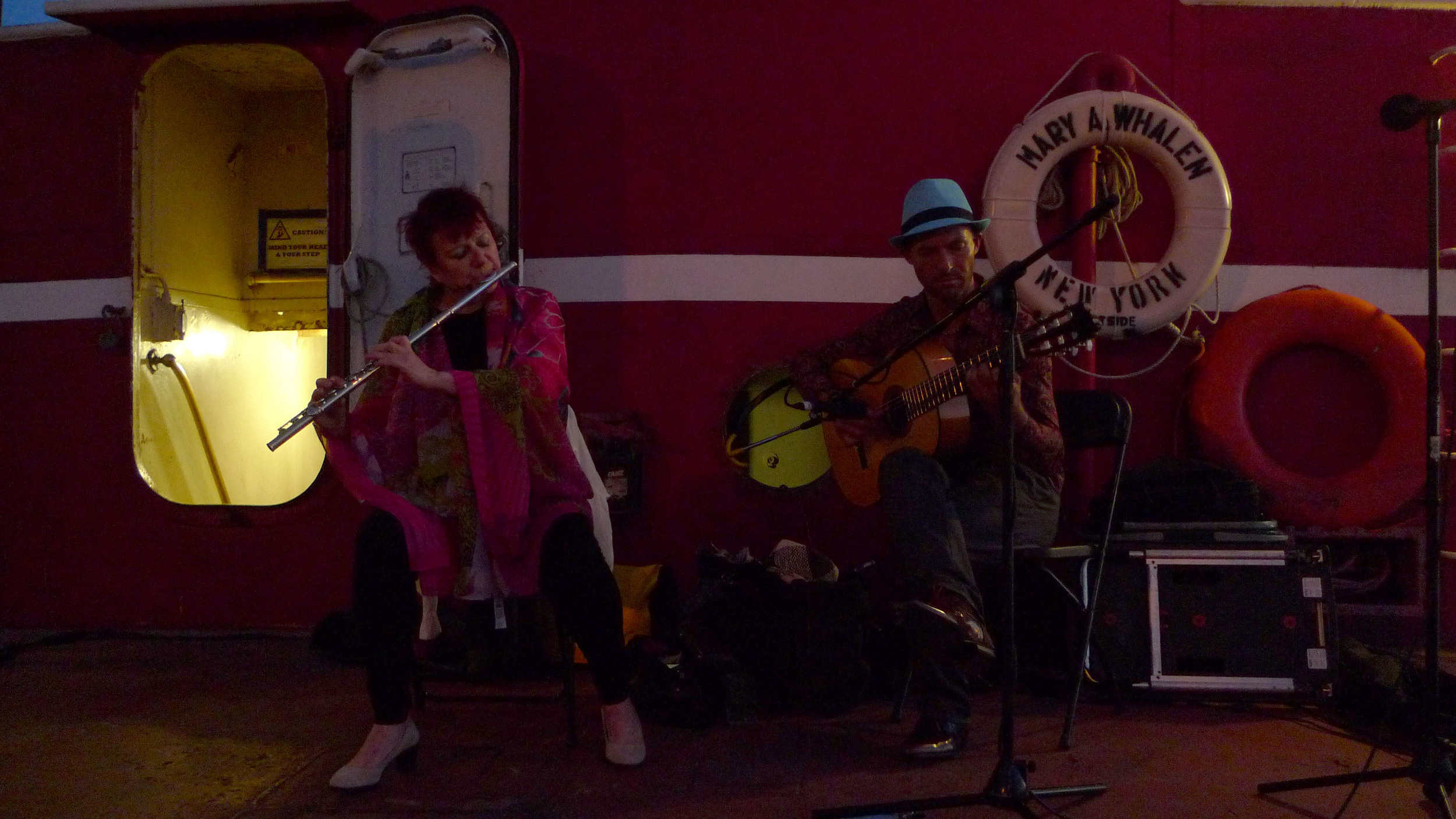
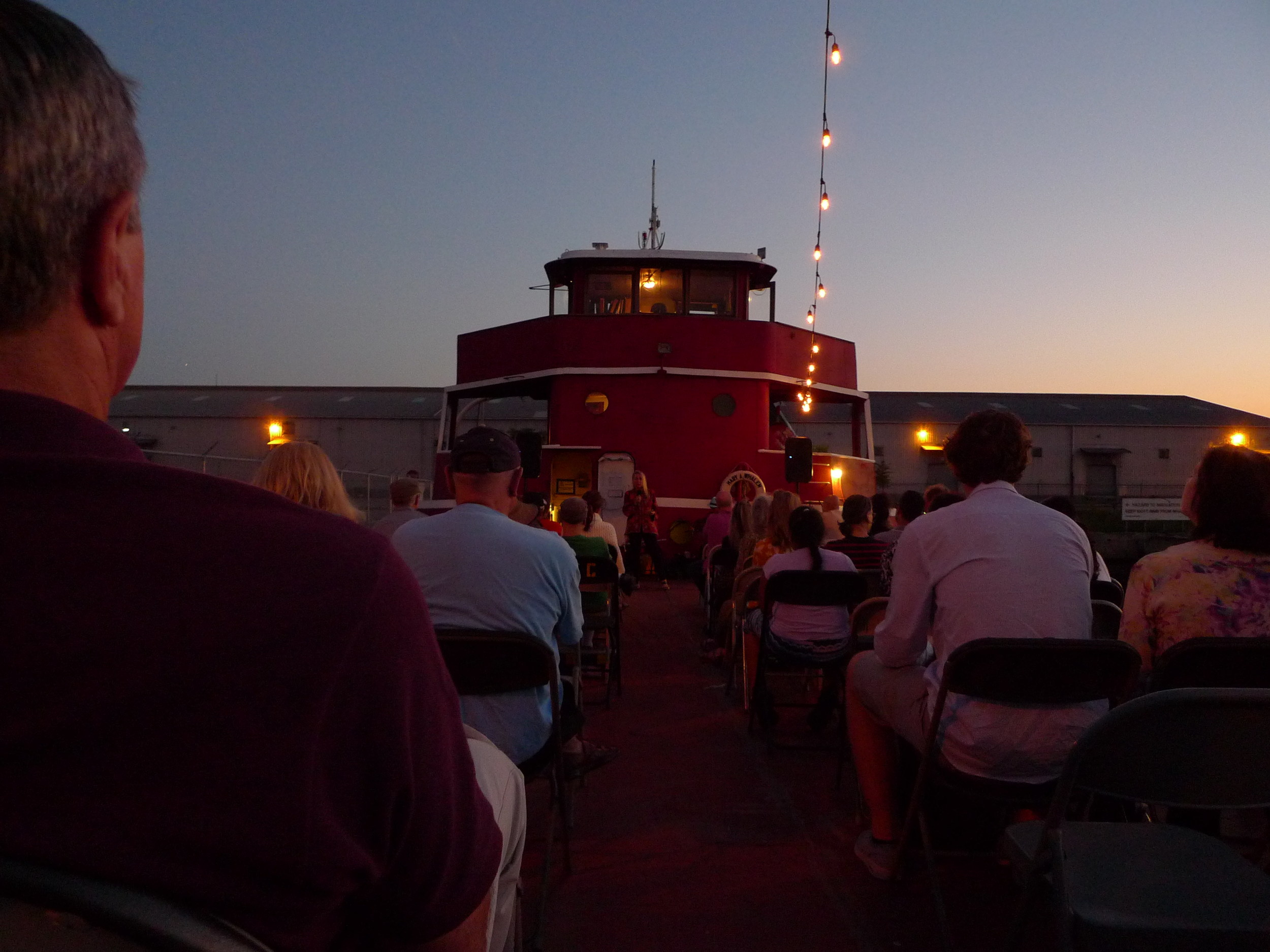
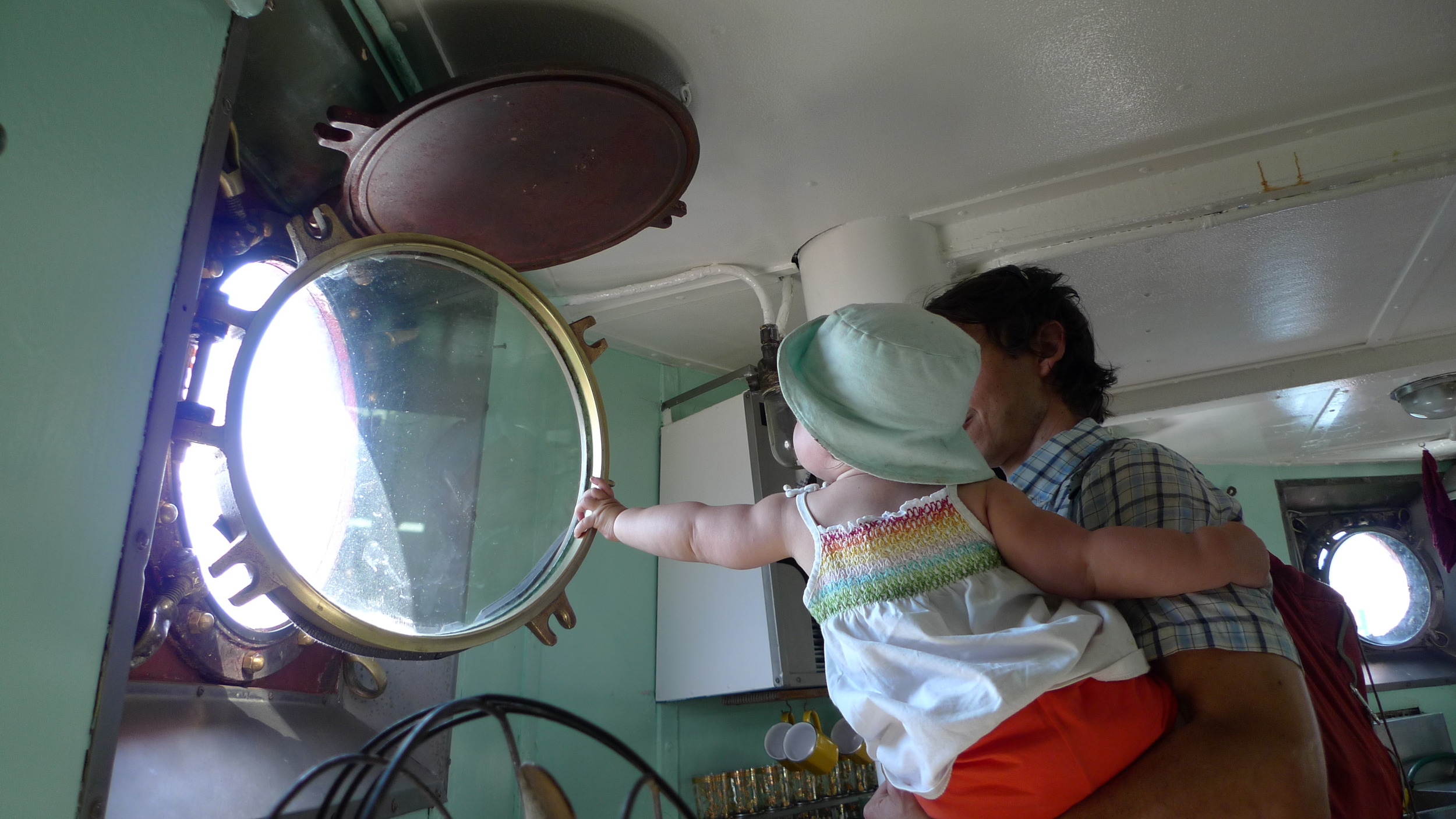
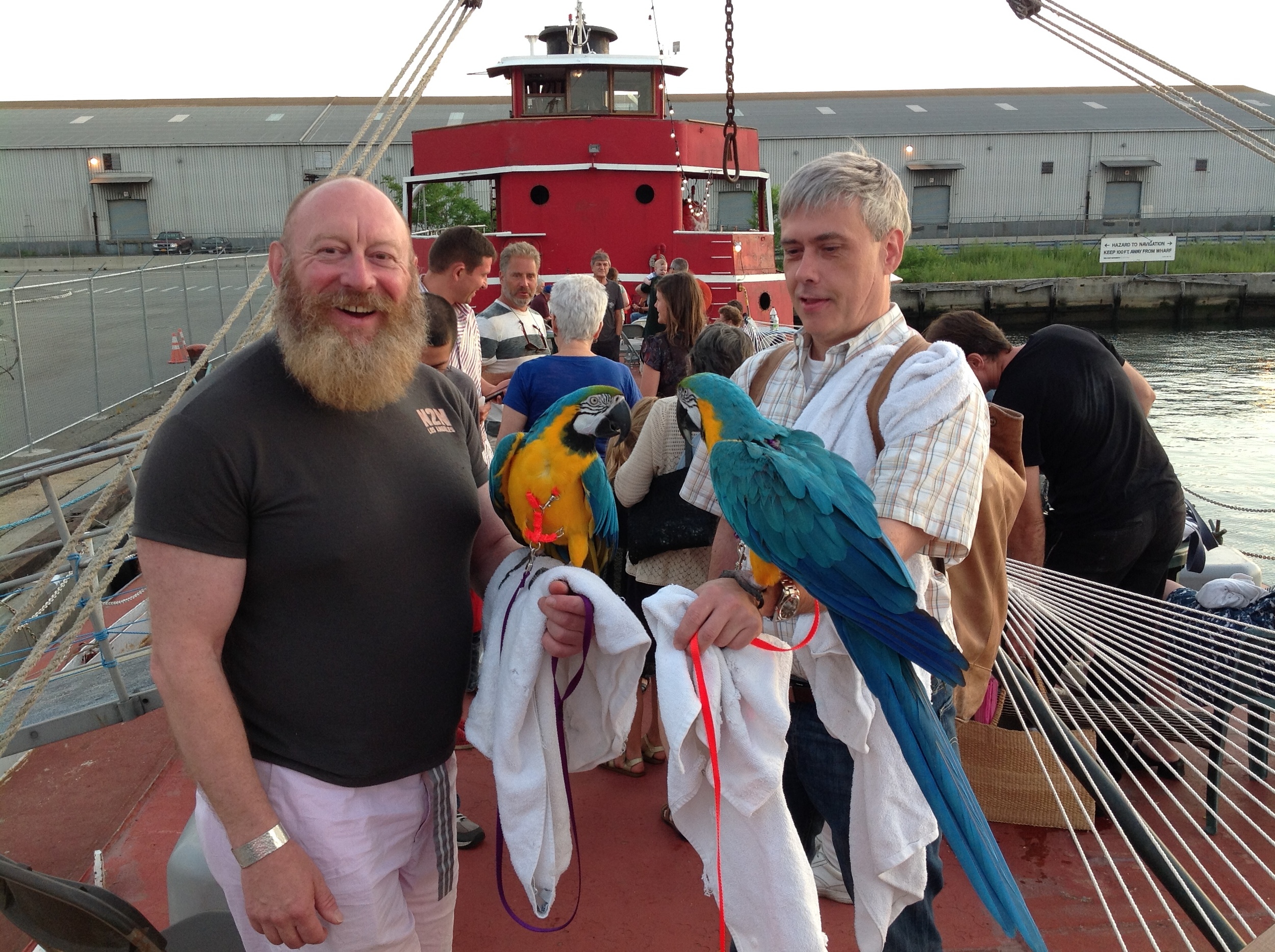

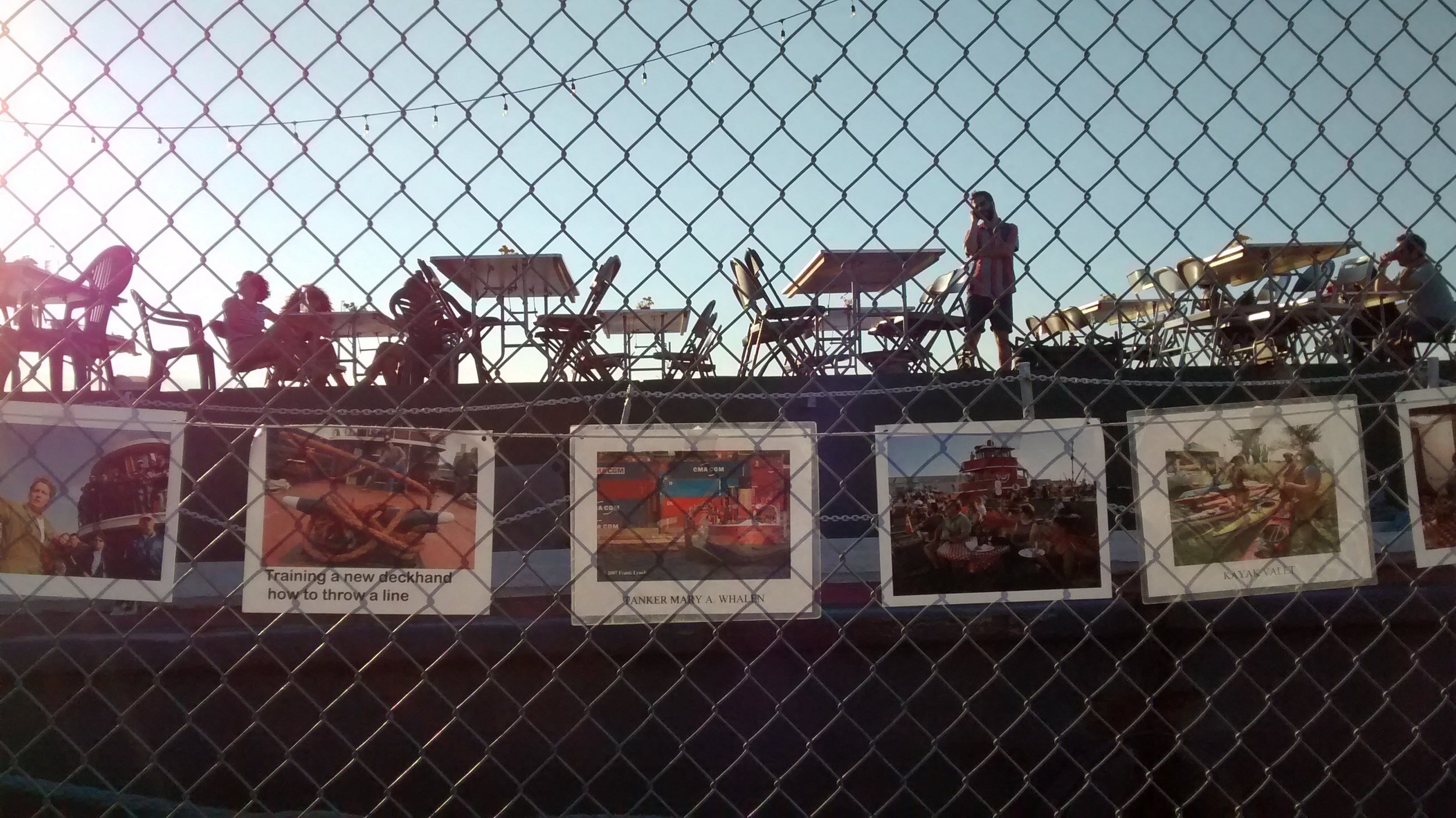
We secured $20,000 in funding from Councilman Carlos Menchaca to support our Red Hook WaterStories cultural tourism, placemaking and resiliency project. We were invited to join a historic ship flotilla that celebrated Cunard's 175th anniversary and got community members in the parade via our partner, the historic tug CORNELL. We curated and ran a great POW! weekend with TankerTours, TankerTime and gifted flamenco jazz musicians who have offered to make this an annual event. We produced a distinctive multimedia history night with Norwegian Red Hook WaterStories with bluegrass musicians from Norway, history speakers, and vintage video. Out shipcat Chiclet has become an attraction, with a growing fan club of regulars who come by to see her.
Volunteers repainted three cabins! Thank you, volunteers! Three summer interns from WHSAD did enormous work restoring the teak rail around the wheelhouse. The painters' union District Council 9 will repaint the exterior as a training excercise with paint donated by International Paint. DC9 scoped out the job, did some prep work, and laid plans for painting in 2016.
History runs through so many of our programs: all events on the ship, programs such as our Norwegian Red Hook WaterStories night, info content we share on our Facebook and Twitter, our blogposts such the one about the important sale of slave ERIE ship in Atlantic Basin which marked an important step in the end of slavery in the USA. In 2015, we added considerably to Mary A. Whalen history: more former crew members found us (thanks to our new home): Engineer Bill Siebert who works on a Vane tug and retired, 86-year old, former relief captain Thomas J. Smith. Captain Smith donated his maritime papers to us, and we have taped hours of interviews with him. A big boost in the history department was the visit by Scott Gellatly and his wife Pat. They ran a waterborne fuel transportation company years ago and almost bought the MARY. The Gellatlys donated photos, recorded hours of interview and brought along retired engineer Bryan Sinram, another trove of history, who had worked for Eklof, the company that ran the MARY WHALEN for years. Walter Barschow donated the folk painting of the MARY aground in the slide show above and gave us leads on Red Hook WaterStories about his family that ran a scrap yard for decades, founded by his German immigrant grandmother. Karen Dyrland and John Weaver donated another large cache of photos, letters and documents from Alf Dyrland, Captain of the MARY from 1962-1978. And, our home, the historic tanker MARY A. WHALEN turned 77!
PortSide continued to inspire filmmakers, painters and multi-media artists. Most find us because they can now see us. The MARY A. WHALEN is visible from our new friends and partners Pioneer Works which leads to a steady stream of artists coming to brainstorm, photograph, get ideas, one even collects salt water for a printing project. We gave the title to the documentary film BLUESPACE and appeared in it. We invited painter Jim Ebersole to memorialize our final week in the Red Hook Containerport.
This important work does not generate inspiring, cuddly or sexy photos. It involves a slew of emails and hundreds of conversations that advance our vision for bringing change to NYC's waterfront. Some highlights: Our President Carolina Salguero was appointed to the Sunset Park Task Force whose first task was to advise the EDC on creating an RFP for SBMT. How's that for alphabet soup! The Task Force continues to meet to shape the Sunset Park waterfront and industrial waterfront district. PortSide provided info and advice on the siting of a Citywide ferry stop in Red Hook. We are engaged with the ongoing work of Red Hook's NY Rising committee. We had a photogenic policy gig by being a stop on Alex Washburn's OHNY Resiliency bike tour.
Getting our new home in Atlantic Basin, has provided PortSide NewYork with much needed stability and allowed us to turn energies to growing PortSide's capacity. We grew the team with 2 board members and 4 advisory board members. We completed the long slog of paperwork of a FEMA Sandy Alternate Project application, along with other important funding applications. We were awarded $20,000 by Councilman Carlos Menchaca to support our Red Hook WaterStories project. In Late October, PortSide launched a year-long growth campaign #GetOnBoard. In December, we were awarded a competitive Regional Economic Development Council grant of $49,500 via the New York State Council on the Arts with the support of Governor Andrew M. Cuomo and the New York State Legislature. We scored new major sponsors in the Weather Channel and International Paint. There is strong growth in the number of entities reaching out to get involved: we have heard from college community service programs, schools, teachers and individuals.
Please donate now and support our momentum!
PortSide NewYork won a White House “Champions of Change” award in April 2013 for our hurricane Sandy recovery work and honors shortly thereafter from the New York State Senate.
A huge part of our Sandy recovery work depended on the generous actions of three people PortSide honored at our fundraiser just before the two-year anniversary of the storm on October 28, 2014 at Hometown Bar-B-Que. More on them below.
Blogpost about the fundraiser in general
Blogpost about our special good neighbor award to IKEA
Victoria Hagman is principal of Realty Collective. So much of PortSide's recovery work after saving the MARY A. WHALEN was enabled by her generosity. Despite Victoria's home having been flooded along with the basement contents of her Red Hook business location, Victoria, without hesitation and no strings attached, allowed PortSide to use the 351 Van Brunt storefront as an aid station.
That offer included free electricity, heat, (and telephone and internet once those were back up.) This became Red Hook’s first small business recovery center, before the location at IKEA, hosting different groups. The storefront housed a gallery at that time, so PortSide had a stylish aid station, and the fact that the gallery was there is a testament to the trust that Victoria offered in making the space available. Several Sandy survivors commented that the white gallery space and bright art was uplifting.
Victoria helped set up a meeting for homeowners to get resilient rebuilding advice from Jim Garrison an architect from Pratt Institute and more. She continues to do work for Red Hook Sandy recovery and resiliency efforts via multiple groups by participating in NY Rising, in special events promoting red hook, a zoning working, being on the CB6 board and the Gowanus CAG, Ready Red Hook emergency response plan… Safe to say, that if there’s some group working to improve Red Hook, Victoria’s probably in it.
James Hill (left) of the Brooklyn Chamber of Commerce presents the award to electrician Danny Schneider
Danny Schneider, the principal of Schneider Electrical Contracting in Park Slope, walked into PortSide's Sandy aid center "351" within days of the storm and offered free electrical services. He had heard through his wife's Facebook page that electricians were needed in Red Hook.
PortSide offered to coordinate his work, and word of the “electrician sign-up sheet” at 351 spread like wildfire in Red Hook. PortSide amalgamated requests by phone, email and text and conveyed them to Danny, who worked off the sign-up sheet.
Danny reports that he inspected and certified sixty buildings (which means many more families than sixty) for free, and repaired some two dozen for the cost of parts. When electrical parts were getting hard to source, he passed that info to PortSide who began hunting for parts in bulk. He battled hours of traffic each day to get to Red Hook; and in the middle of all that, his license was up for renewal so he battled traffic and lines downtown to get that renewed, and came back to help. He also did volunteer electrical repair in the Rockaways.
Danny Schneider also speaks at the end of the video with honoree Victoria Hagman.
Peter Rothernberg (lefti holding his award, and Carolina Salguero (right)
Peter Rothenberg is PortSide’s Historian and Curator. His recovery work includes prevention, restoration of historic artifacts and direct service to Red Hook Sandy survivors, as well as reassuring ministrations to ship cat Chiclet. on our ship during the storm. See video of Peter receiving his award here.
Within the crew of rambunctious wits that is PortSide NewYork, Peter is a quiet, private worker and just the kind of steady guy you want around when a storm is coming and things are going to hit the fan.
Peter helped PortSide prepare the tanker Mary Whalen for Sandy for four and a half days, and he rode out the storm on the ship with PortSide Director Carolina Salguero and Chiclet.
Peter came armed with foul weather gear and four gallons of corn chowder left over from a Brooklyn Botanic Gardens event (after three days of corn chowder, that taste will forever be associated in our minds with the hurricane). He also came armed with a tender heart for Chiclet who had that knowledge animals have that something bad is coming and washed herself steadily for many hours. Peter made Chiclet a tuffet of pillows so she could see out the tankerman’s cabin porthole
During the storm, Peter joined Carolina working outside easing lines… putting a chimney cap on the stove… putting another line around the tarp covering the wheelhouse windows… and the epic job of tying together every dockline not already in use and dragging that through the water to the pier 265’ to the north. That line was to prevent the MARY A.WHALEN from floating up onto the pier, and maybe rolling or impaling herself on a bollard or wreaking any havoc. As the surge waters rose around him, Peter crawled on hands and knees across the jersey barriers along the bulkhead back to the ship.
After the storm. Peter helped rinse out and dry our flooded electrical transformer (which we are still using); and when he found out that Carolina Salguero had forgotten to get our collection of historic documents out of the shed, he set to drying out the collection. Within hours, he had every horizontal surface aboard the tanker covered in wet historic papers, interleaved with whatever we had at hand (sheets, towels, paper towels, wax paper). The stevedores' lounge in the shed was also covered with this project for several weeks.
Peter and Carolina came ashore and set up and ran the aid station at 351 Van Brunt for several days until Dan Goncharoff could make it in from Manhattan to join us. Peter spent much of his time at 351 helping people who did not know how to use computers apply for aid and do other work on the internet.
2022 update: PortSide helped get Red Hook’s Verizon internet back up by calling John Liantonio of the Port Authority. His prior job was to be the cellphone industry rep in the northeast. Carolina Salguero called him and asked him if he could reach key people at Verizon as we had set up an aid station thinking there was internet, and there was none, and Red Hook had been hammered by Sandy. The only internet we were offering was our modem that Peter hung up in a tree out front! Liantonio made the call, Verizon got on it, and Verizon service was up in less than 48 hours! Liantonio did not want this story told at the time.
At our October 28, 2014 Fundraiser "Resiliency is our HOOK," PortSide went off script, as we are wont to do, and gave the Red Hook IKEA store a surprise award.
We presented IKEA with a "PortSide Good Neighbor Award for Sandy Recovery Work" in recognition of the varied, inventive and generous aid they provided for over a year.
We gave this award because we think IKEA deserves recognition at the community level for what their Brooklyn store did for Red Hook after Sandy.
We also gave IKEA the award because we are an educational organization, and we think there are some important lessons in the IKEA Sandy story.
1) IKEA was able to help because they built a resilient building in the first place with the store set high up on a second floor (the garage beneath the store is flood-able space) with elevated electricity and mechanicals. The rectangle of the building was also angled so that a corner faced the water so that it could part waves as does the bow of a ship. Given the surge in resiliency planning talk after Sandy, we think people should be looking at a design that worked and a company that thought to build that way nine years before Sandy.
2) The absence of reporting about IKEA’s large-scale, diverse and prolonged recovery work says something about the media. It shows how reporting clusters around themes, how reporting can be an echo chamber reiterating earlier stories. That a big box store could turn its cafeteria into and aid center and NOT have that generate a single feature story is a remarkable absence. The Fourth Estate can help the discussions of what worked and failed in the recovery period and is going to foster intelligent discussions of resiliency planning, so we ask them to look more closely.
3) Looking to the future, it is important when making recovery and resiliency plans to understand who really did what in the wake of Sandy. We encourage everyone (the Red Hook grassroots level, the consultant/planner/think tank contingent, elected officials and the media) to think about what gaps in reporting about Sandy may exist and research those gaps. PortSide raised awareness of some knowledge gaps in the article “PortSide NewYork & other hidden Sandy Stories” that we wrote at the invitation of the local paper, the Red Hook Star Revue.
IKEA Brooklyn donated furniture to over 25 small businesses.
IKEA Brooklyn donated products directly to local non profits.
IKEA opened its Red Hook doors to National Disaster Organizations (FEMA & SBA, the Brooklyn Chamber of Commerce and others which used half of the cafeteria and other spaces for their operations.
IKEA Brooklyn worked with Tunnel2Towers who brought about 16 box trucks full of donations for their co-workers and Red Hook neighbors for two weeks.
IKEA Brooklyn held a hiring event for displaced workers as a result of Sandy, offering temp work until their home businesses were back on their feet.
Additional work occurred at IKEA Elizabeth, Paramus, & Long Island with each store each working with their local communities.
IKEA provided $250,000 so that GlobalGreen could implement the “Solar for Sandy program” which installed solar power in the Red Hook Rec Center, so Red Hook has one off-the-grid community emergency center. The ribbon cutting was October 23, 2013 just before the first Sandy anniversary.
IKEA Brooklyn subsidized free Red Hook Summer Ferry in 2013 and 2014.
IKEA Brooklyn provided great support for their co-workers:
They brought in 3 counselors to help co-workers cope with the situation.
IKEA converted its large conference room into a makeshift shelter for co-workers and their families.
IKEA US organized a co-worker to co-worker donation program to help those IKEA co-workers who lost their homes or personal belongings.
IKEA received donations from other IKEA stores to give to our co-workers & their families (The store in Virginia sent a truck full of donations, driven up by two of their co-workers).
IKEA US donated over $500,000 in products for the NY/NJ area to disaster relief via the Red Cross.
IKEA donated furniture to firehouses, senior centers, & public libraries after Sandy
IKEA donated home furnishing to a Family Head Start/Early Learning facility in Brooklyn affected by Hurricane Sandy as part of the Life Improvement Project.
IKEA together with Tunnel2Towers:
donated furnishings for those in need in Staten Island and Brooklyn. Beds, mattresses, dining tables and chairs, chest of drawers, sofas. Value approximately $300K at retail dollars.
Product to be delivered to Staten Island and Gerritsen Beach locations.
Donations benefited between 500 to 1000 families in need.
IKEA teamed up with Save the Children and UPS to help refurnish 39 early childhood development centers in New York and New Jersey hit by Hurricane Sandy.
IKEA donated more than $100,000 worth of items, including bookcases, children's tables and chairs, cribs, desks and blankets to devastated child care centers Save the Children is helping to restore, as well as to the charity's Brooklyn field office. UPS is donating delivery services.
IKEA held special Sandy Recovery marketing events:
20% off Kitchens in January to help people rebuild
IKEA Brooklyn discounted moving boxes (Samla) in the months after Sandy
“Funds raised help PortSide continue our mission to bring life to the BLUEspace of NYC’s WATERfront and our hurricane Sandy recovery. ”
Great deco items for home, loft, restaurant. Get your souvenir red hooks here! 4-foot tall turnbuckles! Shackles of all sizes up to multi-ton lift capacity! Blocks (pulleys), weld-on cleats, pad eyes, wire clips, 4 large bollards. Tension testing machine. Vintage scale and wire rope measuring device. Barrels of chain. 1,400 Unislings for bagged cargo, 90 Portabulk bags. Jet Portable folding hydraulic 2-ton hoist. (3) jet 1-ton trolley, (1) each of Jet 1/2-ton hoist w/20 ft, Jet 2-ton pallet puller, Jet 2-ton trolley, and more! EVERYTHING MUST GO!
Riggers, this is real working hardware of industrial scale.
WWII Armory gun rack
Viking 10-person liferaft (distinctive kiddy pool!)
Pilots ladder
Antique Potbelly stove
Large wood crate
2-wheel welder’s trolley
vintage hand truck for moving barrels
modern Wheel barrow
Elliptical hatch frame with bolts (industrial photo frame)
Storage:
***Inventory in ![]() Word or
Word or ![]() Excel (approximate. minus a few things we culled for our ship MARY A. WHALEN) does not include the New Items above***
Excel (approximate. minus a few things we culled for our ship MARY A. WHALEN) does not include the New Items above***
Vehicles enter at Bowne & Imlay (follow signs for Brooklyn Cruise Terminal entrance). Pedestrians and bikes can also enter from the south at a pedestrian gate at the corner of Pioneer & Conover Streets.
Funds raised help PortSide continue our mission to bring life to the BLUEspace of NYC's WATERfront and our hurricane Sandy recovery. As of last count, our Sandy damages run about $300,000. We protected the MARY A. WHALEN, with our offices aboard, from the storm; but Sandy got to everything off the ship on the pier. Many historic items were damaged. Some things floated away forever. We suffer strong indirect Sandy effects. Sandy stalled the urgent search for a home we declared in 2012, since all waterfront sites with which we were negotiating were damaged and dropped negotiations for a while or for good; and we have been unable to earn money with the ship where is it now for about three years.
